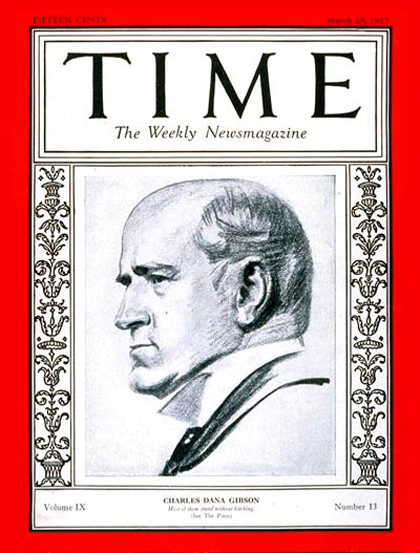
American Graphic Artist
1867 - 1944

Charles Dana Gibson
Charles Dana Gibson (September 14, 1867 - December 23, 1944) was an American graphic artist, best known for his creation of the Gibson Girl, an iconic representation of the beautiful and independent American woman at the turn of the 20th century.
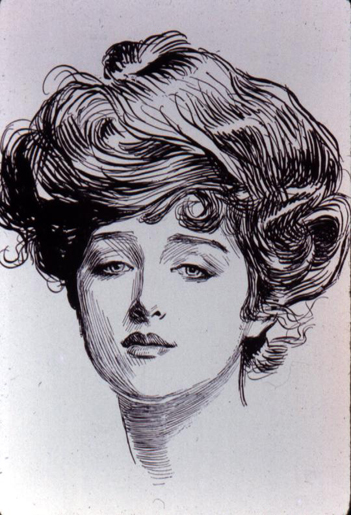
Gibson Girl 1890
Gibson was born in Roxbury, Massachusetts to Charles DeWolf Gibson and Josephine Elizabeth Lovett. He was the great-grandson of U.S. Senator James DeWolf and the great-great-grandson of U.S. Senator William Bradford. A talented youth, he was enrolled by his parents in New York's Art Students League, where he studied for two years.
Peddling his pen-and-ink sketches, he sold his first work in 1886 to John Ames Mitchell's Life. His works appeared weekly in the magazine for over 30 years. He quickly built a wider reputation, his works appearing in all the major New York publications, Harper's Weekly, Scribner's and Collier's. His illustrated books include the 1898 editions of Anthony Hope's The Prisoner of Zenda and its sequel Rupert of Hentzau. The development of the Gibson Girl from 1890 and her nationwide fame made Gibson respected and wealthy.
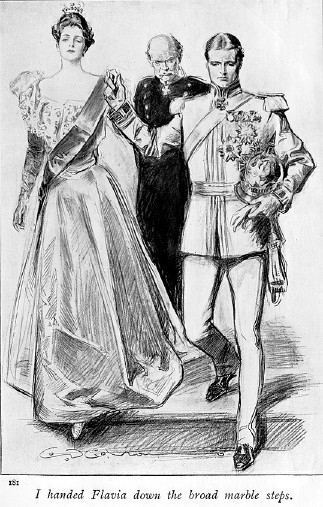
"I handed Flavia down the marble steps."
(From the 'Prisoner of Zenda')
In 1895, he married Irene Langhorne, born in Danville, Virginia, a sister of Nancy Astor, the first woman to serve in as a Member of Parliament in the British House of Commons. The elegant Langhorne sisters, born to a once-wealthy Virginia family devastated by the Civil War, served as the inspiration for the famous Gibson Girls.
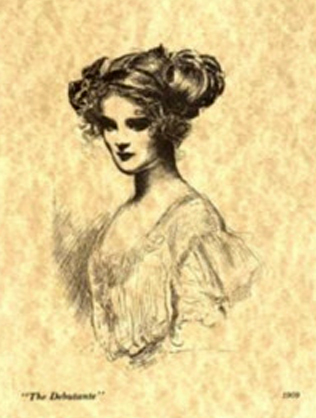
Irene (Langhorne) Gibson
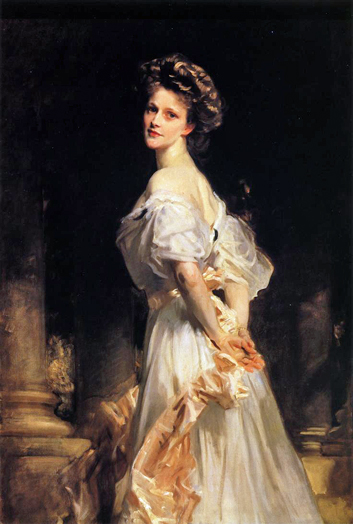
Nancy Witcher Astor, Viscountess Astor
by John Singer Sargent: 1909
He became the editor and eventual owner of Life after the death of Mitchell in 1918. The popularity of the Gibson Girl faded after World War I, and Gibson took to working with oils for his own pleasure.
Almost unrestricted merchandising saw his distinctive sketches appear in many forms. The Gibson is named after him, as he favored ordering gin martinis with a pickled onion garnish in place of the traditional olive or lemon zest.
Gibson owned an island off of Islesboro, Maine which came to be known as 700 Acre Island, where he and his wife spent an increasing amount of time through the years. He retired in 1936, the same year Scribner's published his biography, Portrait of an Era as Drawn by C.D. Gibson: A Biography by Fairfax Downey.
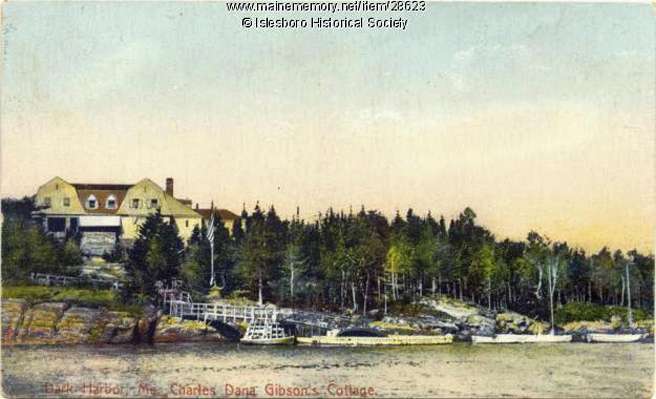
700 Acre Island is located just off Islesboro to the southeast. Charles Dana Gibson, celebrated artist and creator of the Gibson Girl, built a summer "cottage' here in 1904. Gibson spent most of his summers on the island until his death in 1944.
On his death in 1944, Charles Dana Gibson was interred at Mount Auburn Cemetery in Cambridge, Massachusetts.
Quoted From: Charles Dana Gibson - Wikipedia
Charles Dana Gibson
and the Gibson Girls
In Victorian times, illustrators for popular magazines had as much influence on people as movies and television do today. Just as we now look for fashion ideas and moral inspiration from celebrities, actors, or musicians, so the Americans of the 1890's and first two decades of the past century found their hopes and ideals expressed in the pen-and-ink drawings of Charles Dana Gibson.
Many writers have attempted to describe the Gibson Girl, but Susan E. Meyer, in her book America's Great Illustrators did it best and most simply: "She was taller than the other women currently seen in the pages of magazines.. infinitely more spirited and independent, yet altogether feminine. She appeared in a stiff shirtwaist, her soft hair piled into a chignon, topped by a big plumed hat. Her flowing skirt was hiked up in back with just a hint of a bustle. She was poised and patrician. Though always well bred, there often lurked a flash of mischief in her eyes."

America's Great Illustrators
The flash of mischief was not lost upon readers. It was a characteristic they loved, that seemed to exemplify the American spirit of resourcefulness, adventurousness, and liberation from European traditions.
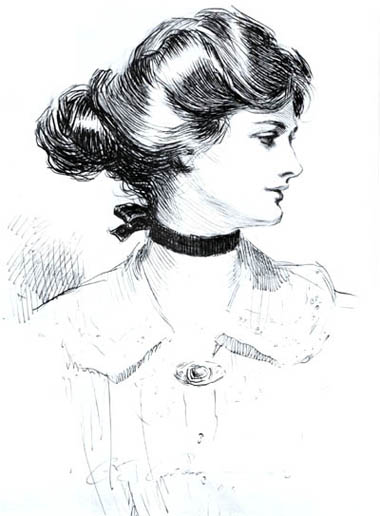
The Gibson Girl
Then "inventor" of this elegant, willowy image of feminine beauty was born on September 14, 1867 in Roxbury, Massachusetts, a descendant of sturdy, hard-working New England stock. His father was a Civil War lieutenant who dabbled as an amateur artist, and his mother was a warm-hearted spontaneous woman who lavished affection and encouragement on her five children.
During a childhood illness, Gibson's father taught him how to make silhouettes of people, animals, and trees, and eventually Charles became so adept at it that when he was twelve, his parents entered his work in an exhibition that gained him his first recognition as an artist.
When Charles was of high school age, his parents scrimped and saved to send him to the Art Students League in Manhattan, a fine school boasting famous painters like Thomas Eakins and William Merrit Chase on the staff. Charles' fellow students included the soon-to-be-acclaimed Western painter Frederic Remington.
Gibson studied for two years, before the financial hardship on his family made him decide to go to work so that he could pay his parents back for their generous support. Unfortunately, the skill that he had displayed as a silhouette artist was not evident, at first, in his pen-and-ink work. He made the rounds of all the magazines and publishers, both large and small - he had good business sense - with no success, until finally in the fall of 1886 he managed to sell, for four dollars, a small drawing of a dog chained to his doghouse, baying at the moon.
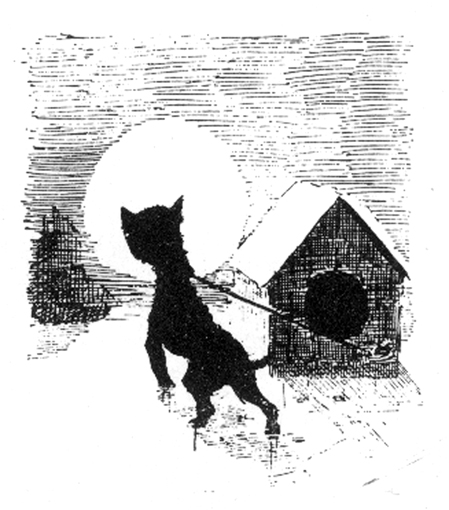
The Moon and I: 1886
Ah, pray make no mistake, We are not shy;
We're very wide awake, The moon and I. The words and music must have been running through the head of the editor, as he looked at: this picture of a comical little dog straining at his kennel chain to bay at a big moon, and read the caption, "The Moon and I." Mitchell smiled that warm smile of his. It was the saintly smile. He tapped his lips with the gesture of reproof he used when he feared he was going to stutter. Then he said: "We're taking this one, Mr. Gibson." Charles Dana Gibson, with a bow to Gilbert and Sullivan, was a successful contributor to Life by virtue of a drawing accepted and paid for on the spot at the rate of four dollars. He walked on air as he left the office. Without any influence brought to bear, without any circumstances favoring him, he had sold a drawing to a stranger, to the editor of a real magazine. It could be done. Sighting a restaurant across the street, he realized that the walk in from Flushing that morning, plus the excitement of his triumph, had made him ravenously hungry. By way of celebration the elated young artist blew in seventy-five cents of his four almighty dollars on a large chicken pie.Quoted From: PORTRAIT OF AN ERA by Fairfax Downey
The purchaser of this work was Life Magazine, at that time an influential humor publication edited by John Ames Mitchell, an artist himself. Although he thought Charles' work was crude, he saw the "honesty and courage" in it, which led him to give Gibson guidance and then more work - for the next thirty years.
Gibson was nothing if not determined, and he parlayed his first sale (after celebrating his new professional status with a seventy-five cent chicken pie) into an ever-growing business. Month to month his income increased steadily, and he found himself a studio. He pored over English and American magazines for new techniques and ideas, and when, in 1889, he was earning enough money for a trip to England and Paris, he went there specifically to study.
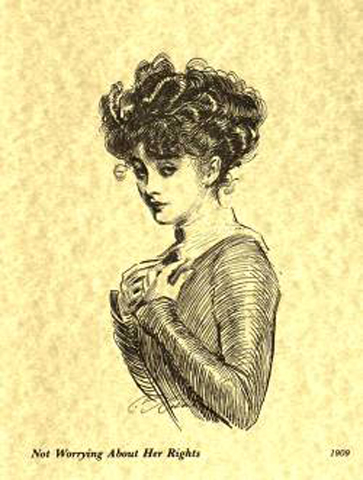
Not Worrying About Her Rights: 1909
He met his idol, the English artist George du Maurier, who did satiric drawings for Puck, and when he came back to America Gibson developed a new vitality in his style. Du Maurier was famous for his drawings of striking society women, and soon Gibson would be, too.
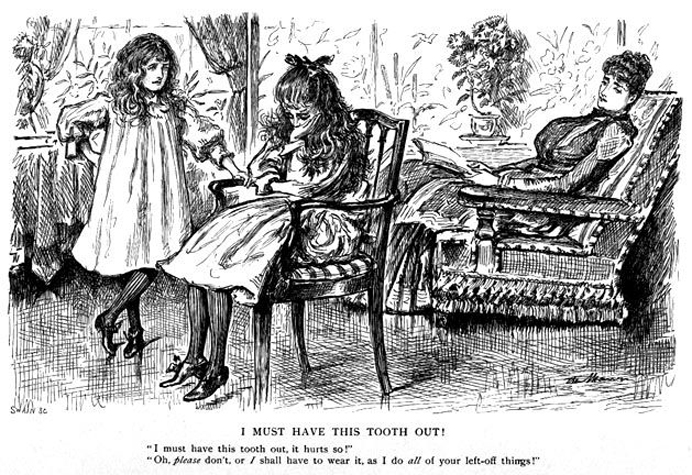
I Must Have This Tooth Out
by George du Maurier
The Philosopher's Revenge
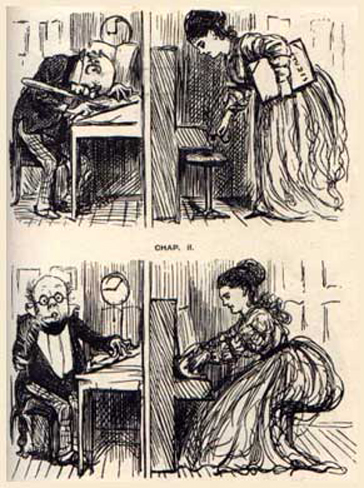
George Du Maurier was a famous British artist, cartoonist and
novelist. He was born in Paris, but came to London to work as a
chemist. His first cartoon was published by magazine Punch in
1860. He remained at the staff until his death. Among his sequential
work include 'The Philosopher's Revenge'. Later in his life his eye
sight failed, which led him to drop drawing and turning to writing
novels. He was the grandfather of the famous British novelist
Daphne Du Maurier ('Rebecca').
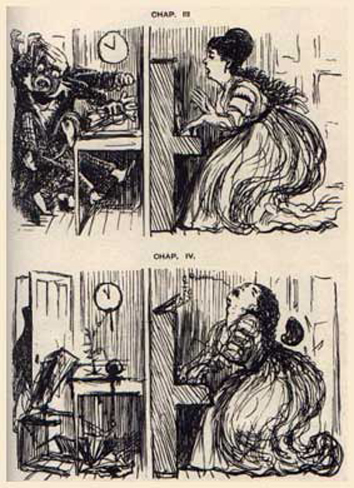
By 1890, the artist was working for all the major publications in New York: The Century, Harper's Monthly Weekly Bazaar plus doing his weekly drawings for Life. Then, with the creation of the "Gibson Girl", as she came to be called, he became - in modern parlance- a superstar.
The Gibson Girl was, in the artist's own words, "The American Girl to the Entire world", even as she raised her new-fangled golf-club and cried "Fore!" She was spunky and sentimental, down-to-earth and aristocratic at the same time. And she appeared in drawings that captured with bold craftsmanship such timeless themes as love, money, self-deception, and social climbing. One brilliant and moving series published in 1899 even shows the Gibson Girl from infancy to old age.
Gibson Girl
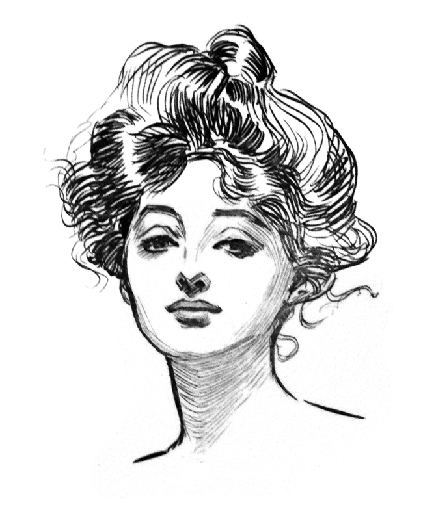
Gibson's captions gave the drawings, with their masterly evocation of mood through light and shadow, the quality of short stories. And indeed, in such series as "Mr. Pipp's Education", which was about a henpecked husband and his family traveling through Europe, Gibson created the visual equivalent of a novel.
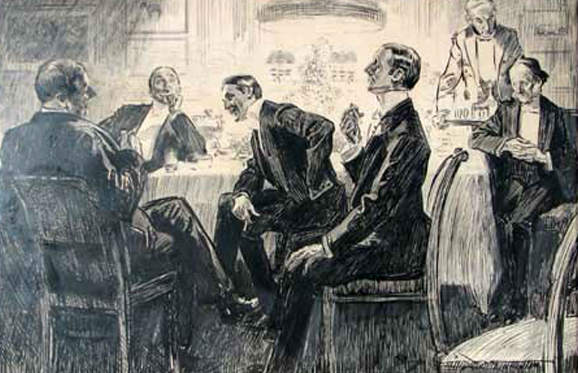
Mr. Pipp's Education
The country rewarded this artist and social commentator (he preferred to see himself as the later) with the greatest adulation ever seen up to that time for an illustrator. Not only did he become a social lion and New York's most eligible bachelor (until he settled down with Virginia society belle Irene Langhorne in 1895), but he saw the nation decree "Gibson-Mania" for the next two decades.
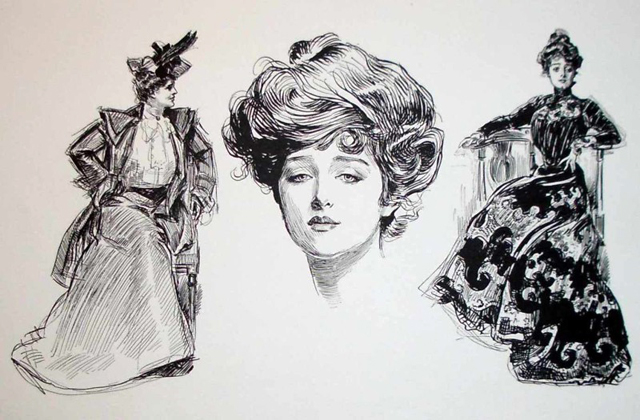
Irene Longhorne Gibson
There was merchandising of the Gibson Girl on the level of Mickey Mouse or Star Wars. Large size books ("table albums," they were called), china plates and saucers, ashtrays, tablecloths, pillow covers, chair covers, souvenir spoons, screens, fans, umbrella stands...all bore the image of Gibson's creations. There was even wallpaper for bachelor apartments, with the lovely Gibson faces in endless array. A popular turn-of-the-century hobby, pyrography, saw people burning the Gibson Girl into leather and wood; and the image was traced and stitched into handkerchiefs. There were plays, songs, and even a movie based on his creation.
Amid this adulation, the well-bred young ladies of the time came (with their chaperones) to Gibson's studio to pose; later, many of them claimed to have been the "original" Gibson Girl. And to keep his heroine company, the artist developed the Gibson Man, (for whom he himself could have passed), handsome, courteous, romantic, and almost at all times subtly in awe of the gorgeous Gibson Girl; for what comes across most clearly in the drawings is that Gibson felt women were clearly the superior sex...at least in terms of points per game!
There several different aspects to the vision Charles Dana Gibson had of feminine beauty.
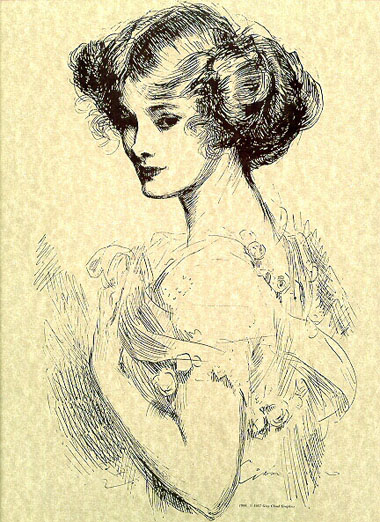
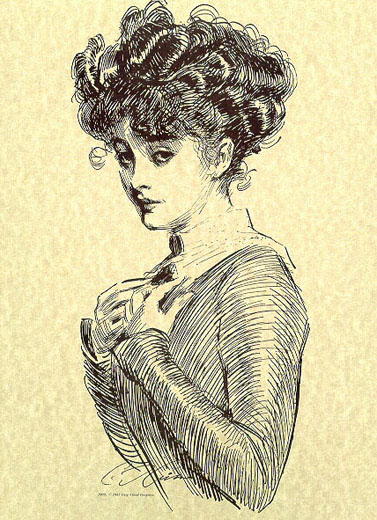
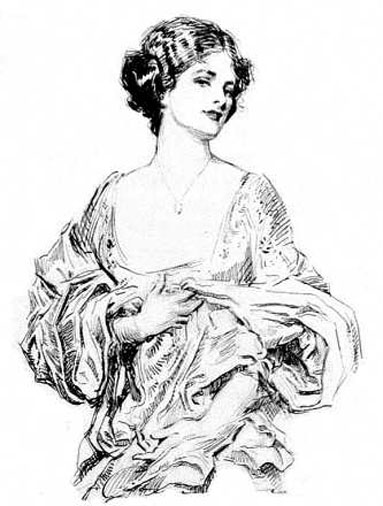
Yet the important thing is that Gibson was able to show this in a way that never offended men; if anything, his male audience must have nodded in comradely, if rueful, agreement Charles Dana Gibson's elegant drawings captured the spirit of an age. Never before had an artist stirred such commercial interest. Magazines fought for the exclusive rights to his services in negotiations which made headlines; but no matter what agreements he made (and Colliers offered him unheard of thousands of pre-tax dollars if only he would be theirs alone), he always maintained a connection to Life, the publication that gave him his start.
Indeed, after World War I (during which Gibson led his fellow artists in creating soul-stirring patriotic art) and the death of his mentor John Ames Mitchell, Gibson took over Life himself, as editor. Unfortunately - or perhaps it was fortunate from Gibson's point of view, because now he had the time to paint in oils, which his busy schedule had long precluded - the end of World War I brought a change in the country's attitudes, and John Held's flapper drawings took the place of the Gibson Girl in the public's heart.
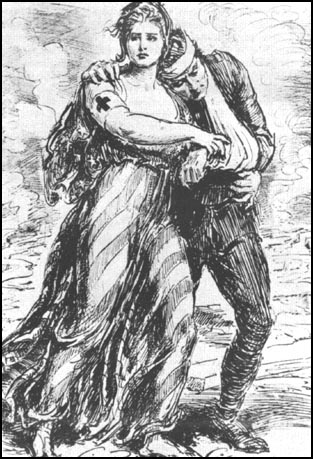
Columbia's Greater Task: 1918
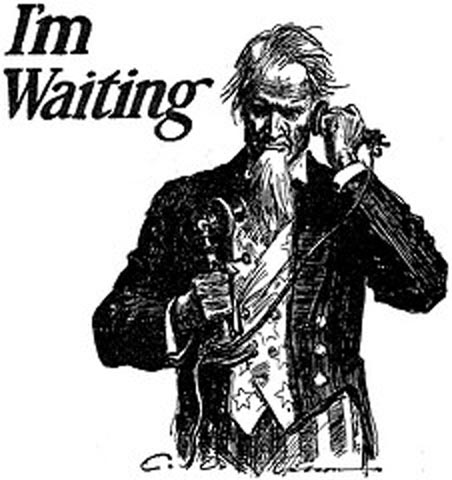
I am Waiting

National League for Women's Service
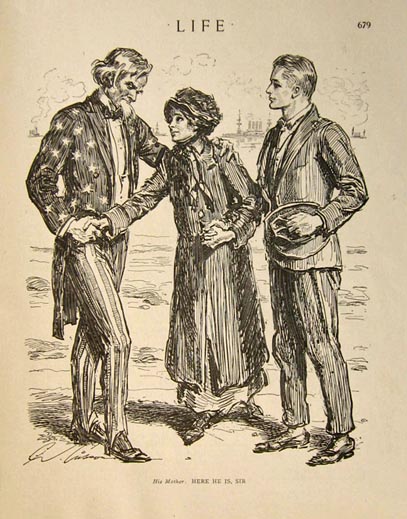
Life - Uncle Sam: 1917
Gibson dedicated himself to his paintings, depicting his surroundings and family near his home in Maine, and he earned critical acclaim for his efforts. By the time of his death in 1944, the world was much different indeed, but Gibson's spirit certainly lived on, especially in the rash of 1890's nostalgia movies produced in Hollywood in the early 1940's.
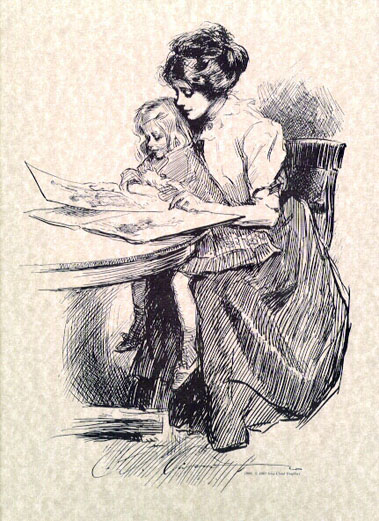
As critic Henry Pitz wrote in The Gibson Girl and Her America... "he used his talent to express his most earnest convictions. He was not a consciously deep prober, but many of the surface features to which he was sensitive had deep and mysterious roots. He had a lot to reveal about the characters of his era and had more than a little to do with the shaping of it".
Quoted From: Gibson Girl - Lively Roots
The Gibson Girl: Imitation is the Sincerest Form of Flattery
The Gibson Girl was created by Charles Dana Gibson, one of the many illustrators selling their work to publishers of periodicals in Manhattan in the 1890's.
In time he acquired many more clients and was earning enough to rent his own studio. In 1889, when this illustration shown above appeared in The Century magazine for March he had saved enough money to finance a trip to London and Paris. The technique shown in this drawing is what I would call slash and scratch. It was all that most illustrators ever mastered in black and white, and is to be found as well in the work of most cartoonists of the period. It is a far cry from his famous, and so often poorly imitated, brilliant later style shown directly below.
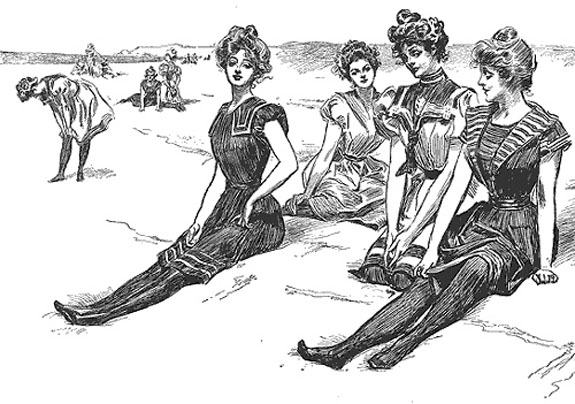
Women at the Beach
While in England, Gibson met the very famous writer, illustrator and wit, George du Maurier whose lyrical style of pen-and-ink illustration set him high above the rest of his peers. However good du Maurier was in depicting beautiful women, Gibson surpassed him. He became supercharged as a result of finally meeting his idol and returned to New York revitalized and truly reinvented himself with his "Gibson Girls".
This is a copy of an original Gibson drawing of 1903 entitled "The Weaker Sex", which the artist gave to the Library of Congress in 1935.

The Weaker Sex
The incredibly beautiful teenage showgirl, Evelyn Nesbit, was the subject of this famous Gibson drawing entitled "Women: the Eternal Question", and published in 1905 when Nesbit was probably only 18. Evelyn Nesbit was the nubile object of prominent but profligate architect Stanford White's affection and the obsession of his murderer, the infamous Harry Thaw.
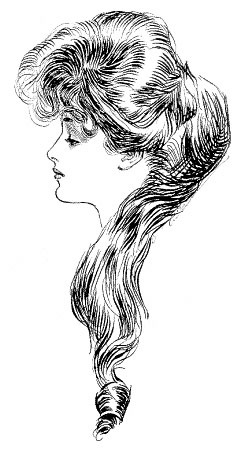
Women: the Eternal Question
Quoted From: 100 Years of Illustration: The Gibson Girl - Imitation is the Sincerest Form of Flattery
Gibson's Influence
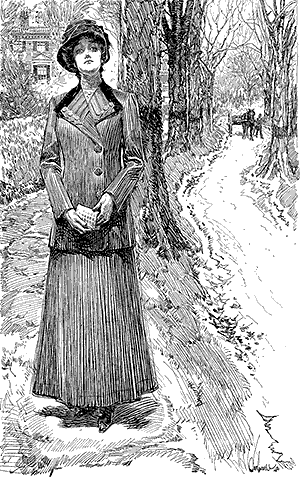
Gibson's Influence
Orson Lowell, 1871-1956, was a master draftsman considered to be in many ways superior to Gibson in his pen-and-ink renderings, but he didn't have the clout that Gibson had. Personally, I think it's more about the characters than technique. The Gibson Girl seemed to have personality that transcended the medium of print. She was to artwork what Marilyn Monroe and Brigitte Bardot were for photography.
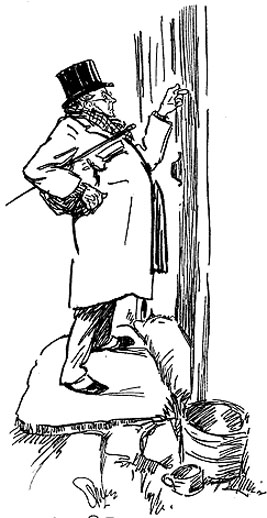
Muckraking
May Wilson Preston, 1873-1949, was her own person, strong-willed and dynamic, and a fighter for women's rights. It's evident in her style that is not in the least derivative. She owed nothing to Gibson, despite his enormous influence at the time.


Harrison Fisher, 1875-1934, got in the American Girl theme and segued from magazine illustrations to portraits of celebs.

Howard Chandler Christy, 1873-1952, was another. This is not one of his best and the reproduction is messy. He did a lot of very nice portraits after he left the magazine business. One of his finest is that of First Lady Grace (Mrs. Calvin) Coolidge. Here's another link to more of his work.
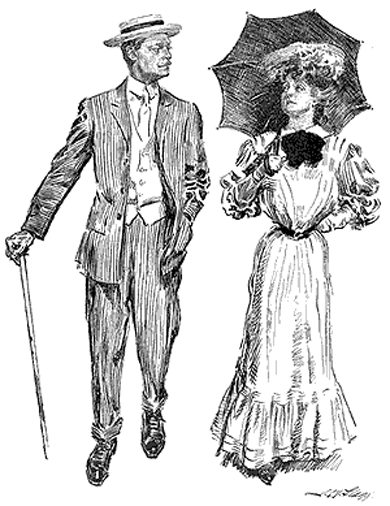
James Montgomery Flagg, 1877-1960, was a child prodigy who sold his first illustration at the age of 12, according to his bio in this hotlink. He was a blatant imitator of Gibson and probably got a lot of work because of the astronomical (at the time) prices that Gibson demanded.
![]()
He was even signing like Gibson in this illustration for the December 1906 issue of Scribner's.
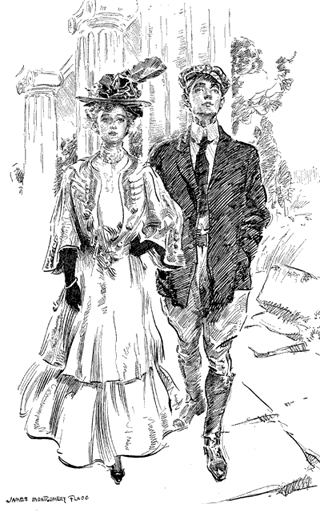
This is from Scribner's of February 1909.

Finally, Monty Flagg's most famous illustration, produced to promote enlistments in the U.S. military at the time of World War I. It has become an icon for almost a century.

Another of my favorites is Florence Scovil Shinn, 1871-1940. She obviously didn't feel compelled to scratch away with her pen in homage to Gibson. She, too, will reappear in these postings at a later date. She became famous in a later career as a motivational writer and speaker.
She was one of four wives of the notorious Ashcan School painter Everett Shinn, 1876-1953.

Quoted From: 100 Years of Illustration - Gibson's Influence
Various Works of Charles Dana Gibson
This is one artist that I enjoyed for his simplicity, honesty, and unique representation of his art. I used several sources for background information so some of it was redundant and for that I apologize. I wanted a broader context for Gibson's work. I have to admit I was intrigued by his Gibson Girls and the mystique he gave each one. I was also interested in his social commentary and how he depicted different human relationships. All of this is again my personal opinion and comes from no professional training or expertise. It is simply my reaction to Mr. Gibson and is art.
Senex Magister
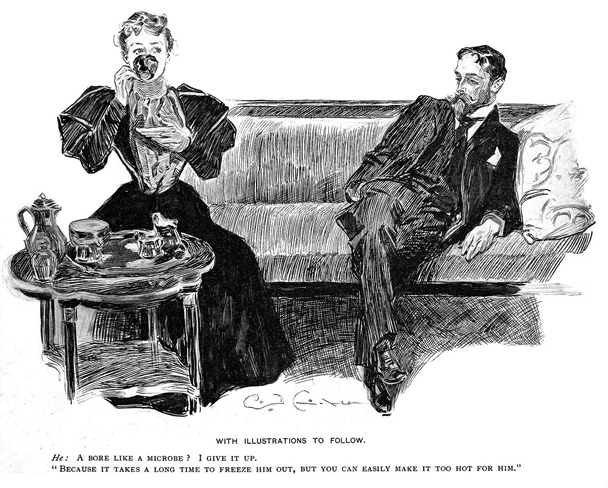
A Bore

A Family Decision
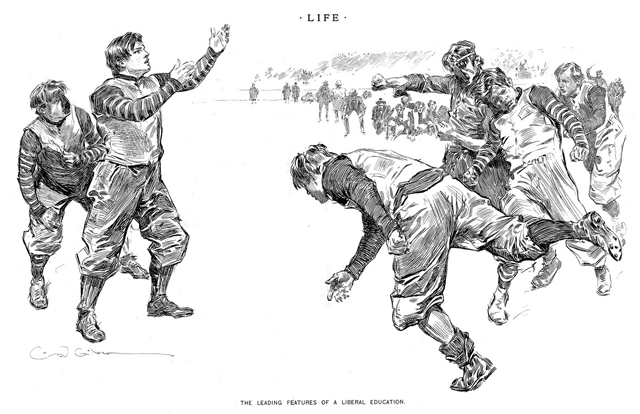
A Liberal Education
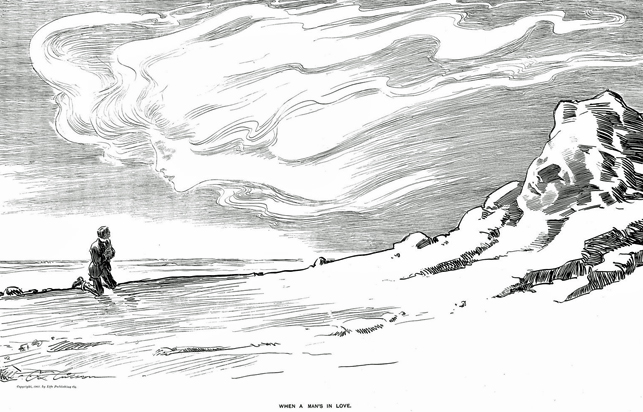
A Man in Love
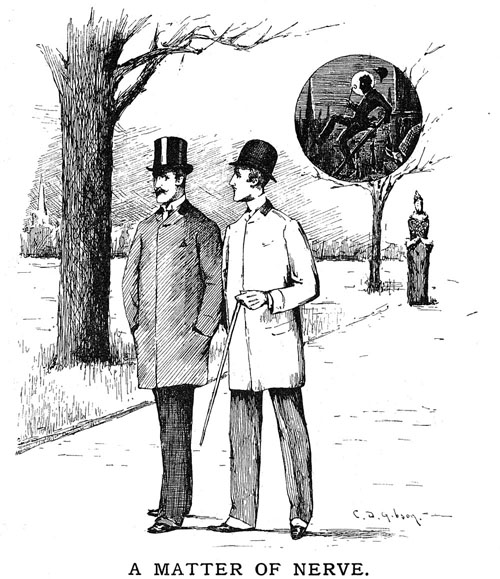
A Matter of Nerve
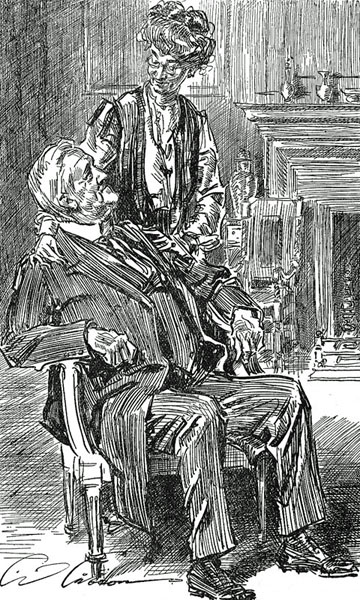
A More Mature Couple

A Widow and Her Friends

A Widow and Her Friends

A Widow and Her Friends
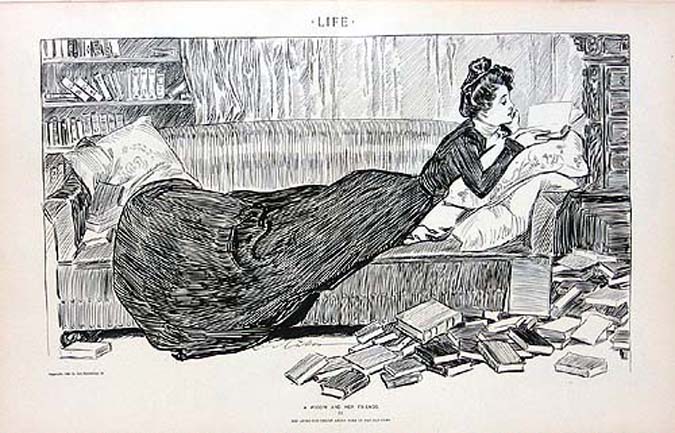
A Widow and Her Friends
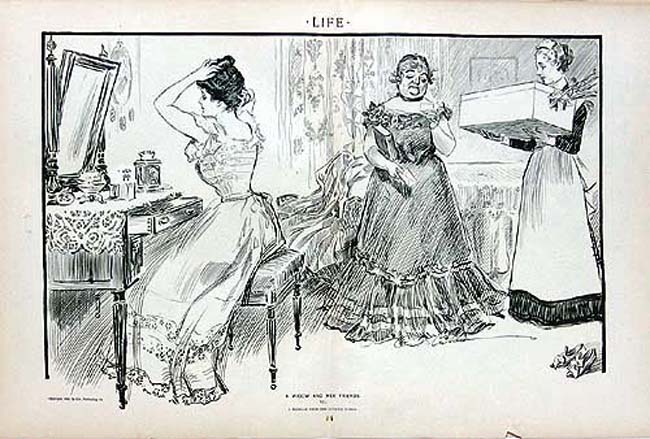
A Widow and Her Friends
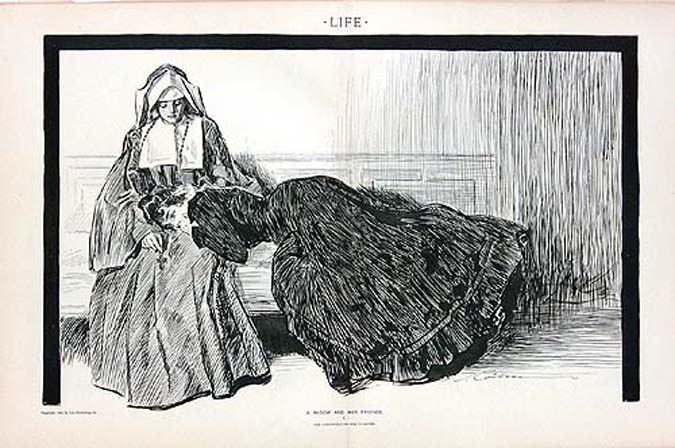
A Widow and Her Friends
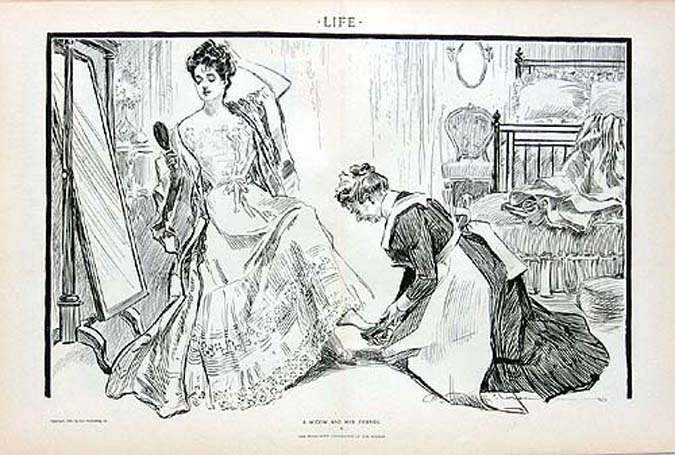
A Widow and Her Friends
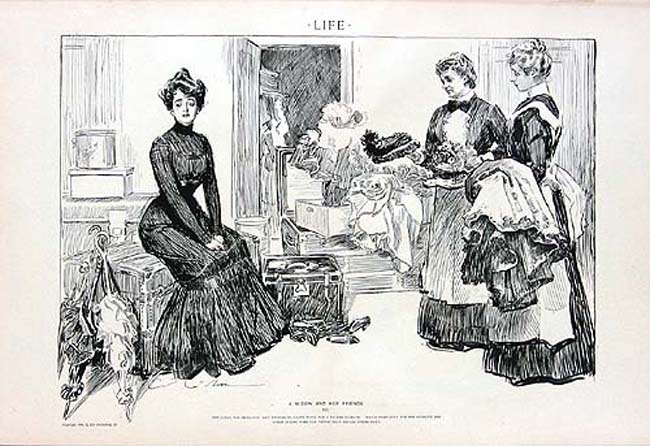
A Widow and Her Friends

A Wife's Explanation
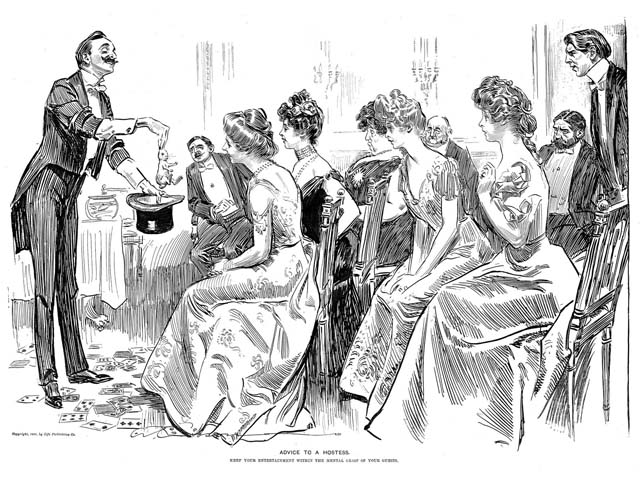
Advice To A Hostess
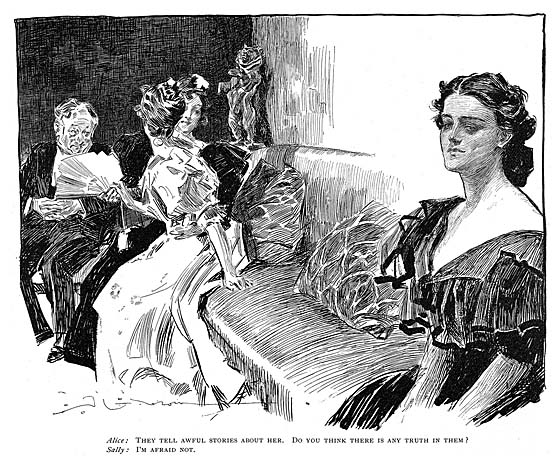
Alone

Art Lesson
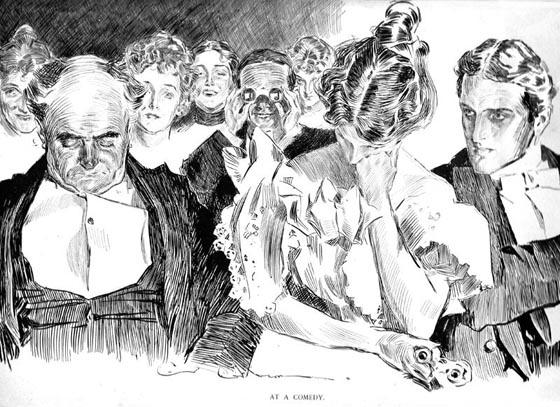
At A Comedy
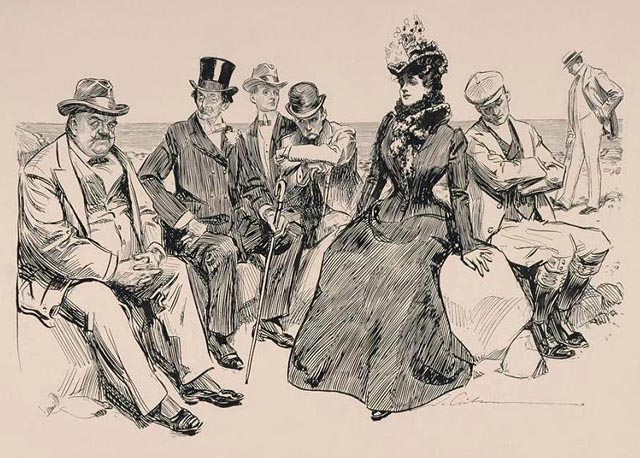
At the Beach, Gibson
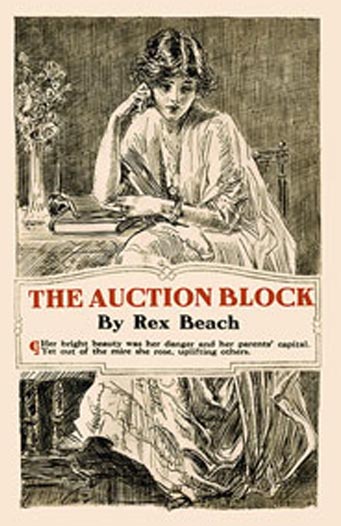
Auction Block Bookmark
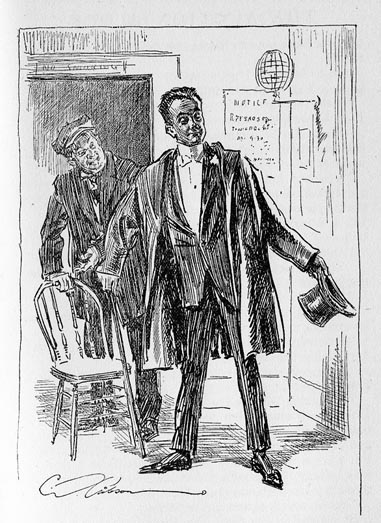
Back Stage

Blue Bird Weather Illustration

Blue Bird Weather
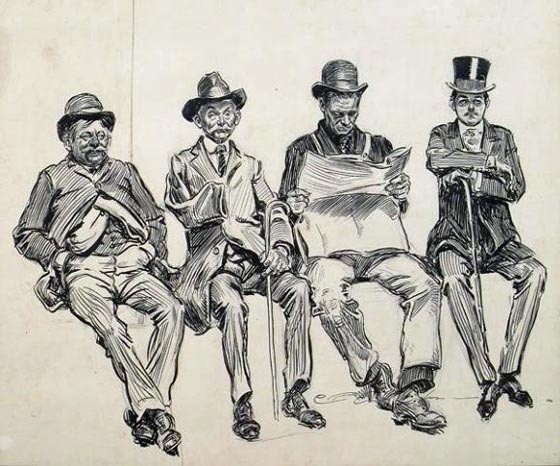
Brothers

Cafe
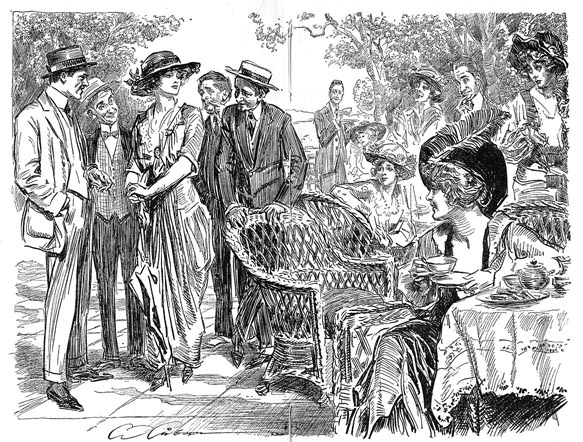
Center of Attention

Common Law Illustration
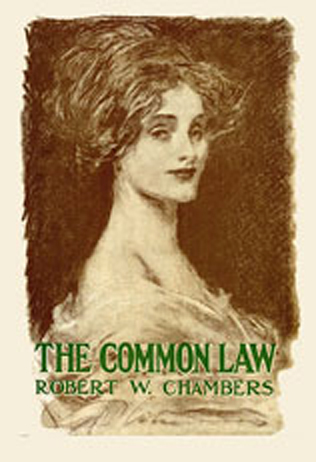
Common Law Bookmark

Death
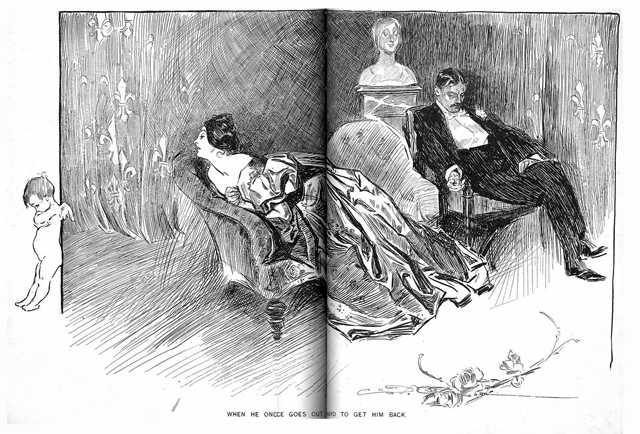
Death
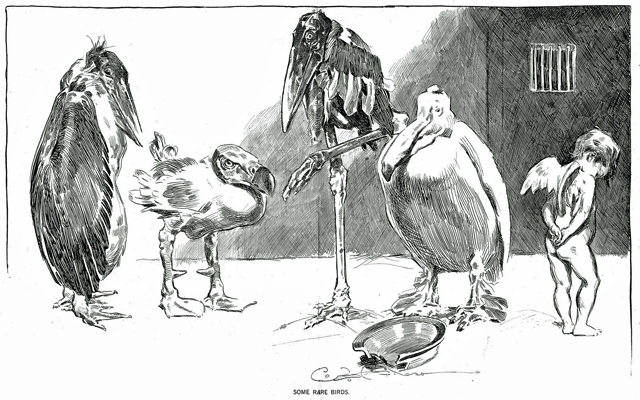
Death
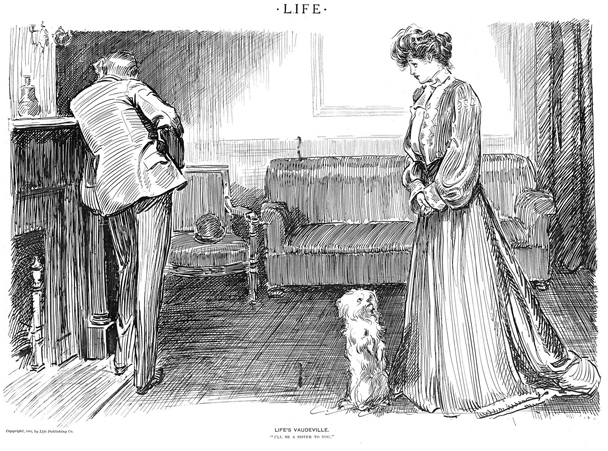
December 15, 1904

Dinner
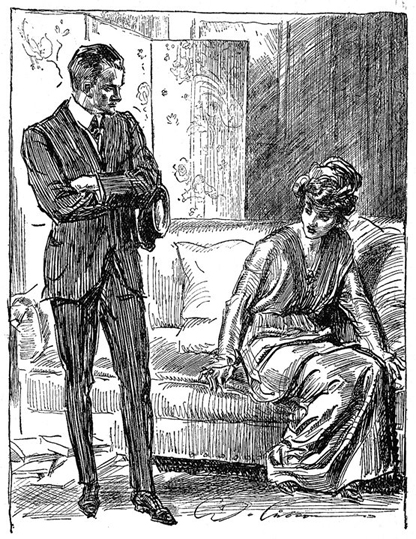
Discussion
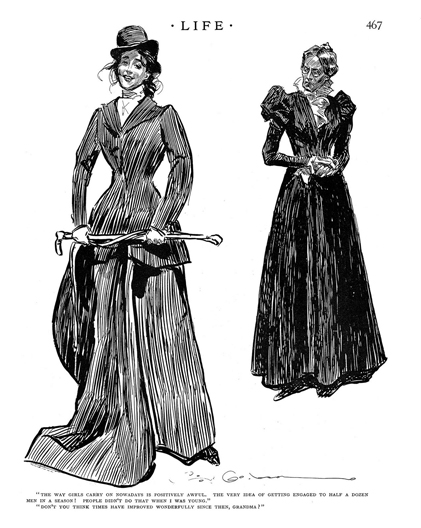
Discussion
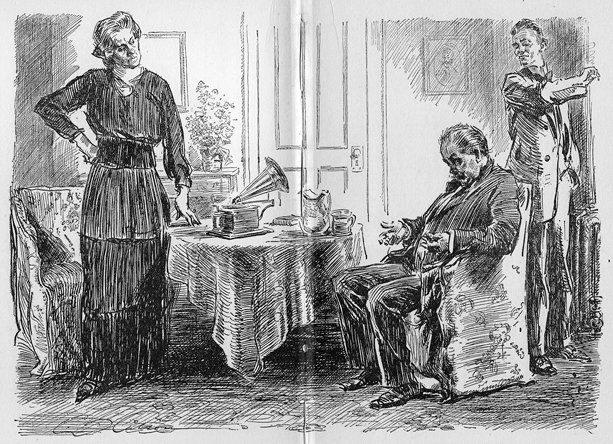
Domestic Scene
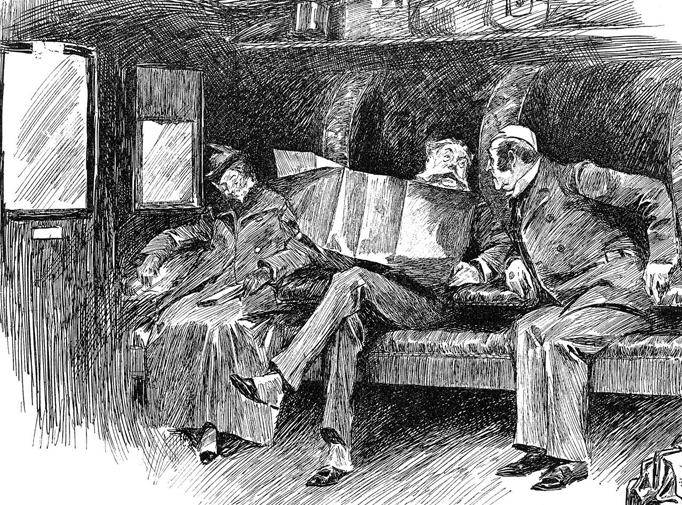
Every Inch A Duchess

Everything in the World That Money Can Buy
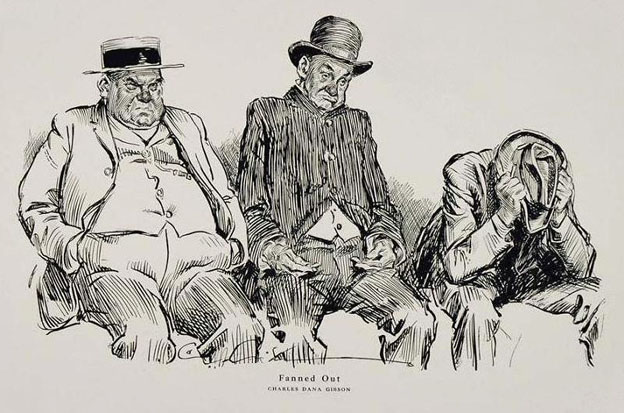
Fanned Out
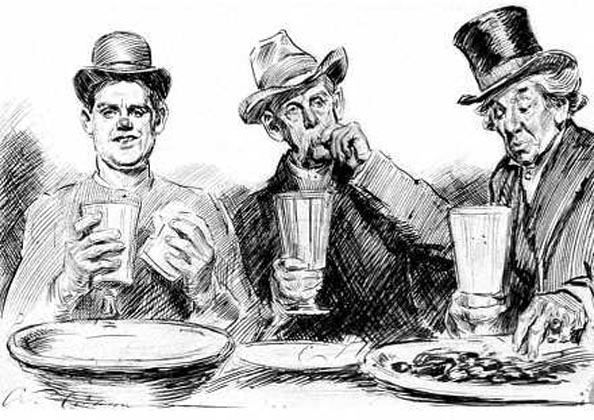
Free Lunch: 1911
More of the Gibson Girls
It is easy to come to Charles Dana Gibson's creation of this ideal feminine form from different points of view. The perfection of the hourglass figure can be criticized as a masculine fantasy that in the end demeans women and refuses to recognize the reality of the diversity of body structure which is a part of our shared humanity. There is another aspect to the 'Gibson Girl' which has already been addressed by other writers with which I tend to agree. I believe Mr. Gibson thoroughly loved women and was enthralled by the power of femininity as he perceived it. In a post Civil War society he saw a new woman emerging who was strong, independent, and self assured. Yet, this woman still lived in a world that remained male dominated. What Mr. Gibson recognizes, I believe, is the unique individuality of each woman and, at the same time, rejects the idea that a woman could only exist as an extension of her husband. Have we reached that level of enlightenment? I doubt it but I do think we are getting closer. If you haven't recognized it, I love Charles Dana Gibson's depiction of his 'Gibson Girl' in all her different variations.
Senex Magister
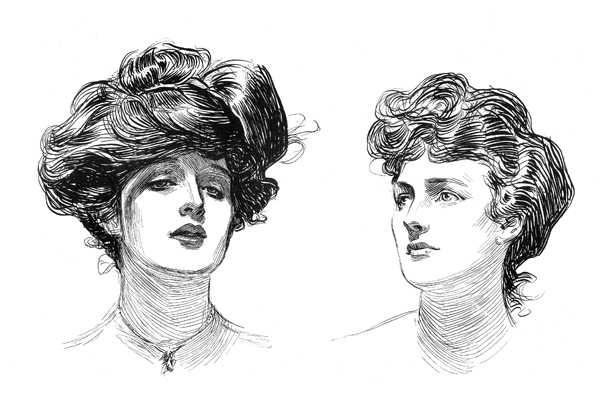
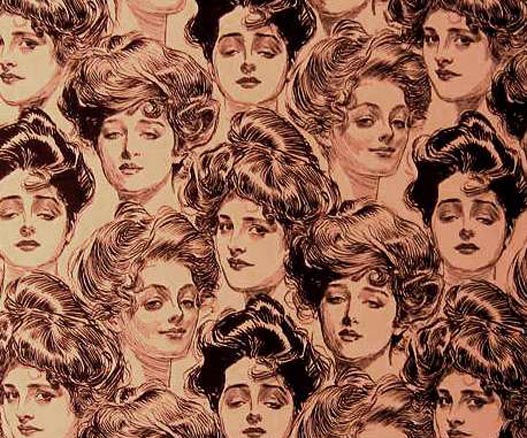
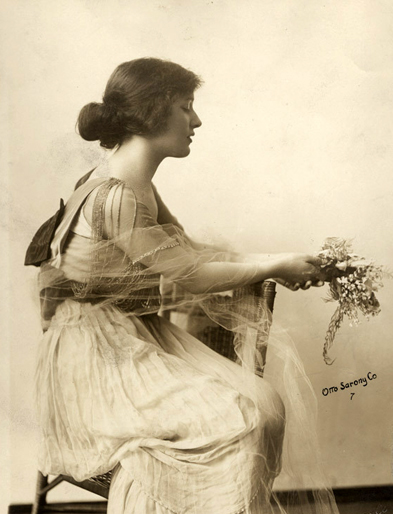
Evelyn Nesbit: ca 1910

Gibson's Depiction of Evelyn Nesbit
Phtographs of Evelyn Nesbit
Story of Evelyn Nesbit and the Thaw-White Murder
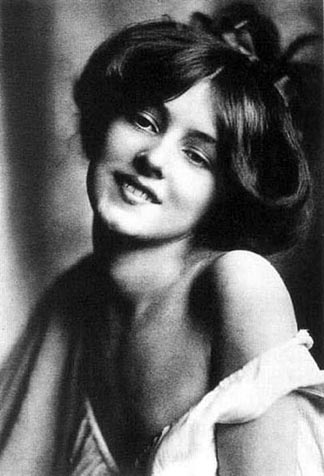
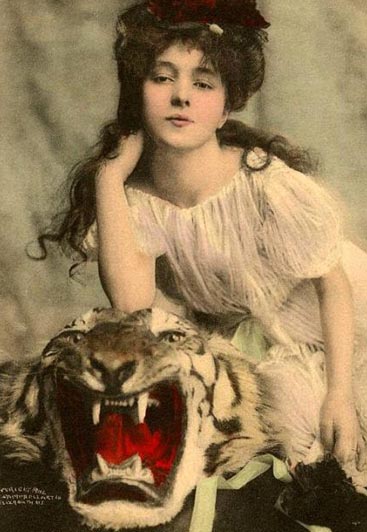
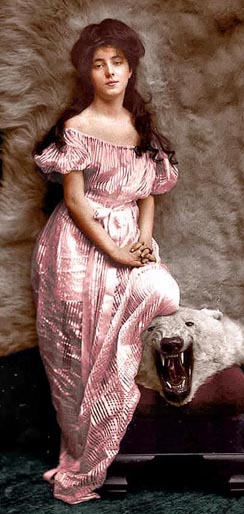
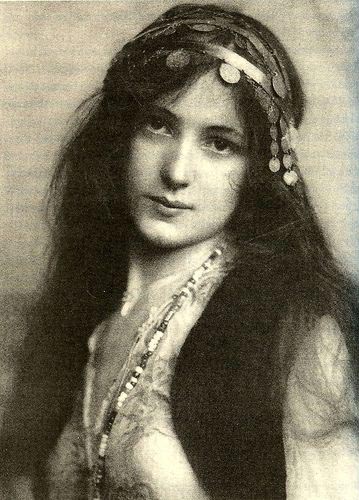
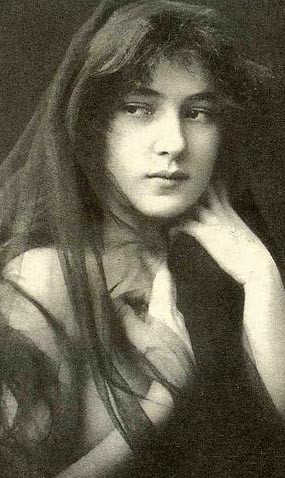

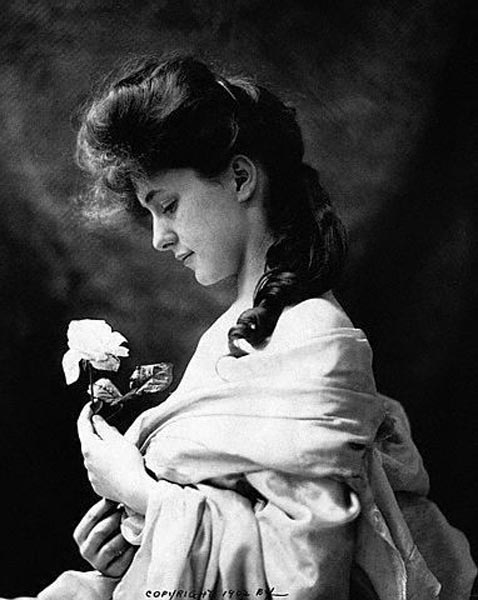
Compare the photograph to her 'Gibson Girl' illustration.
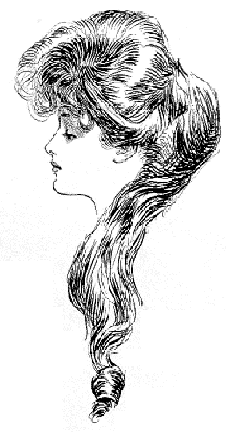
The Gibson Girls Again

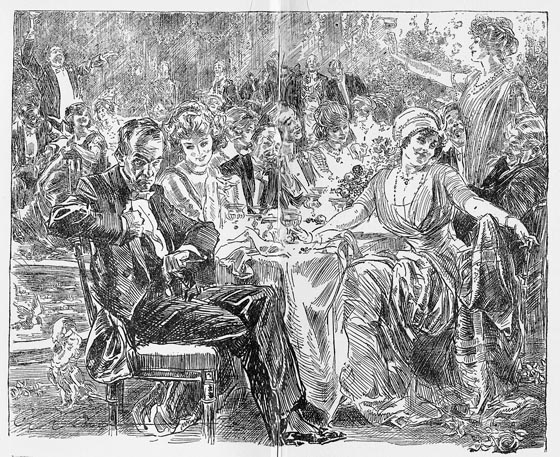



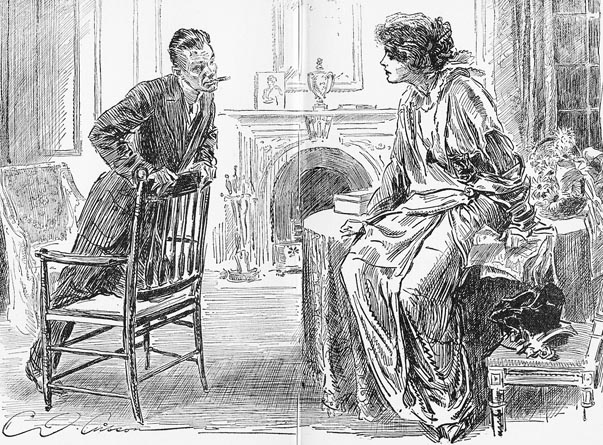
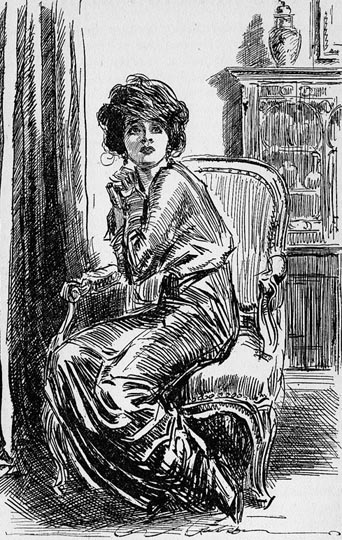


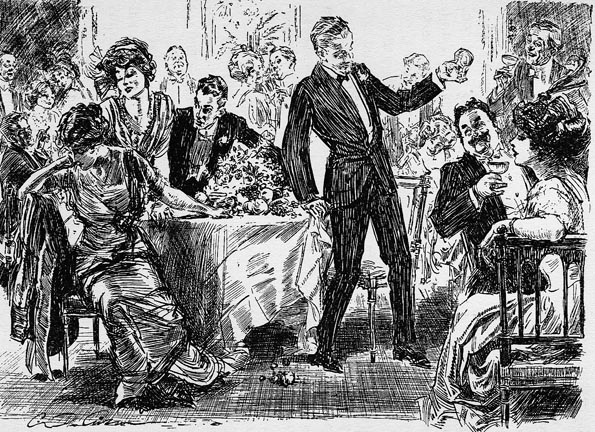
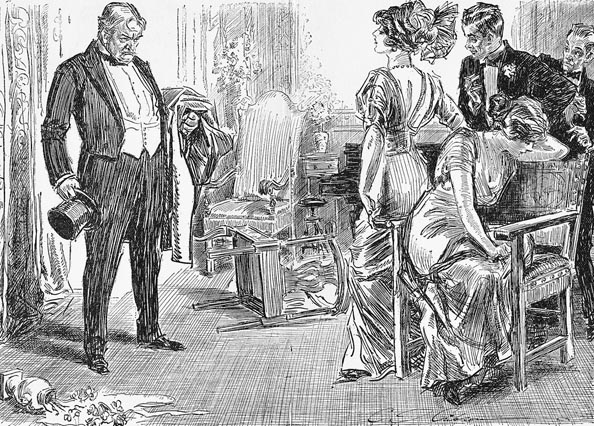
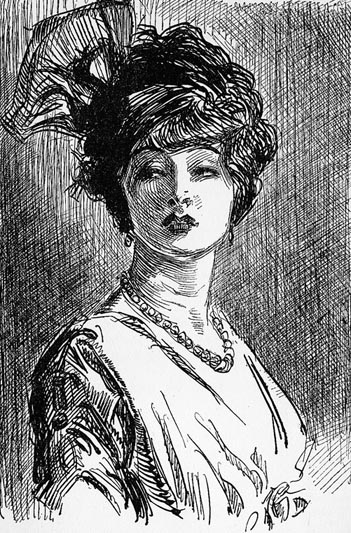

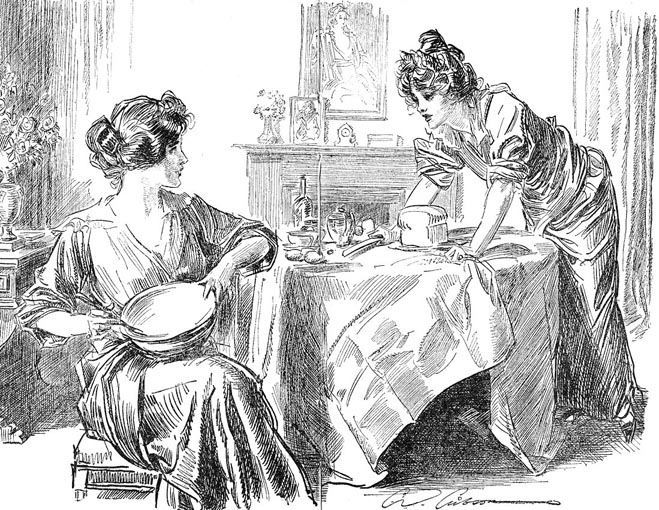
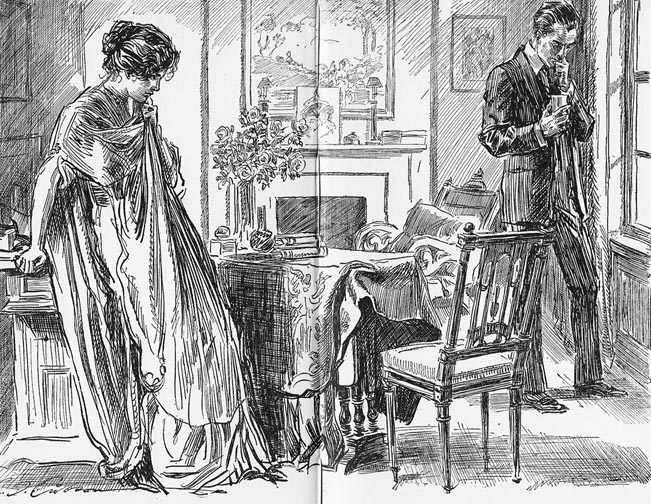
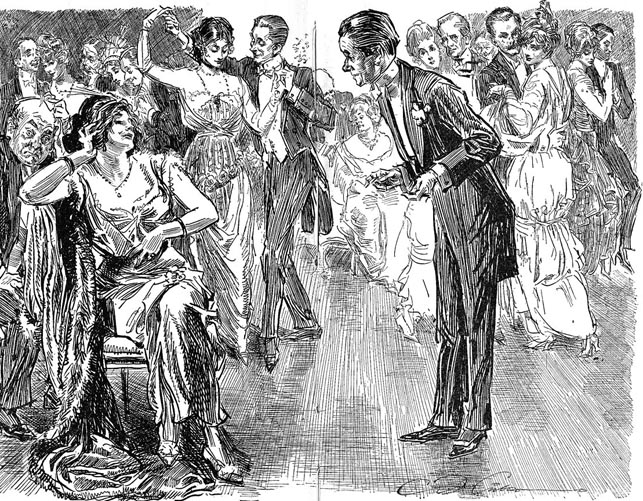
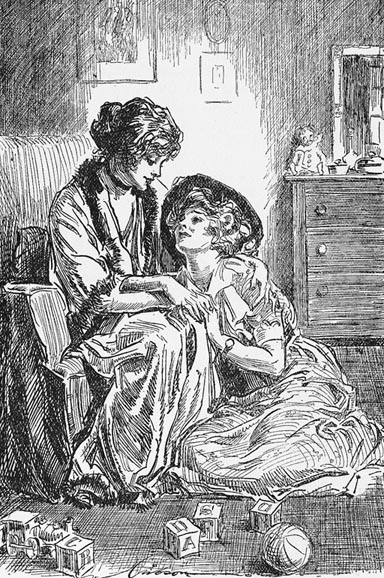
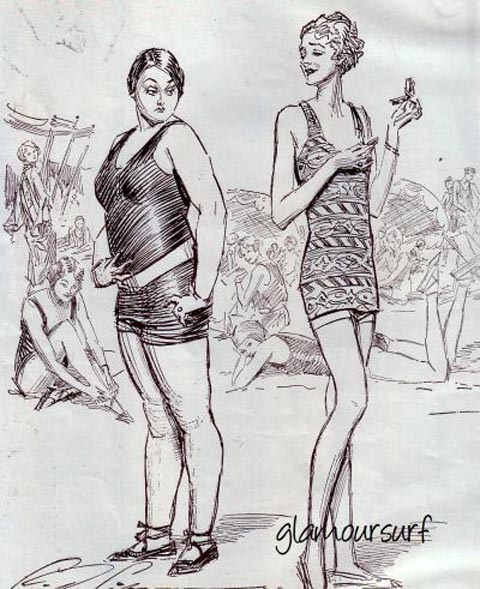
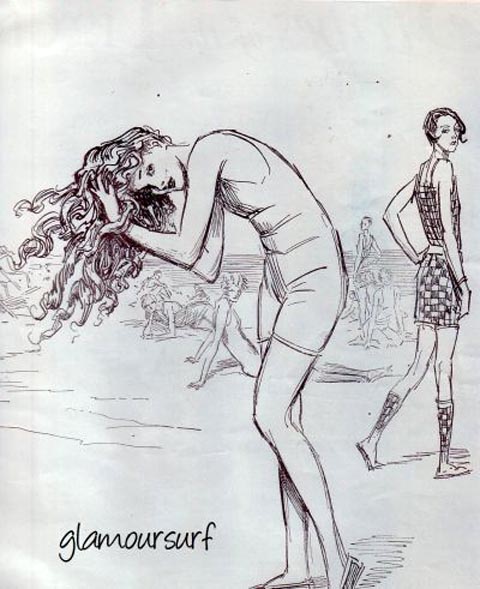
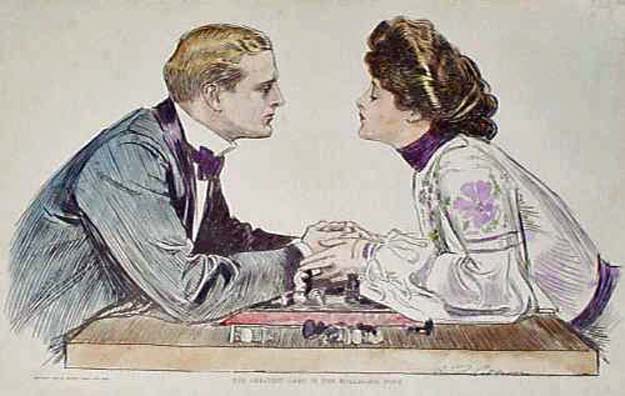
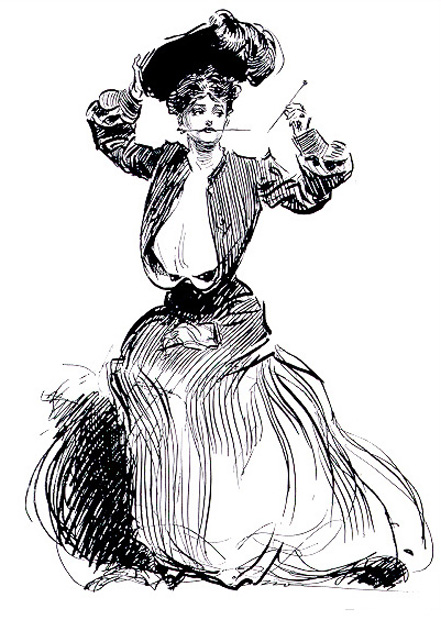

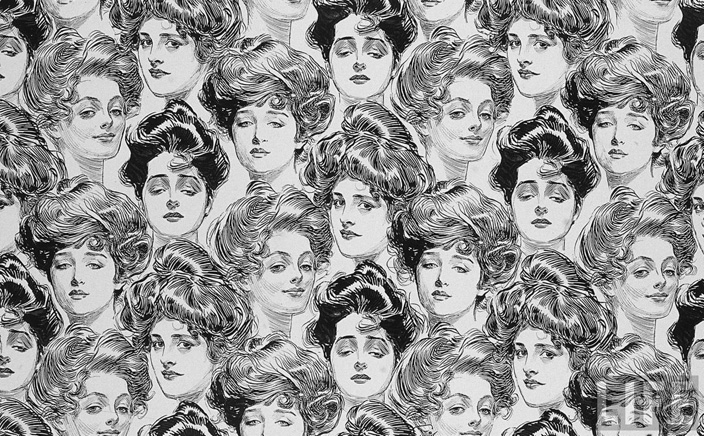
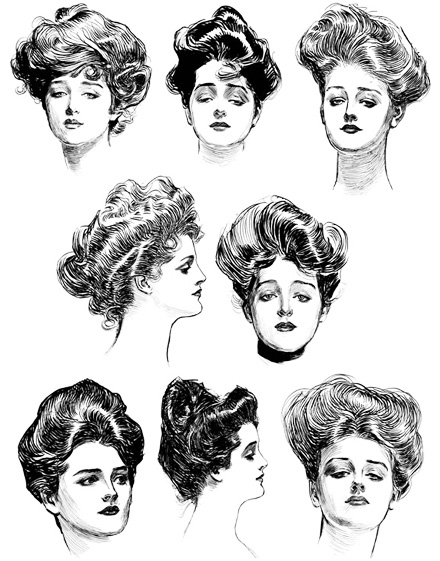

Gibson's Illustration of Women's Clothing
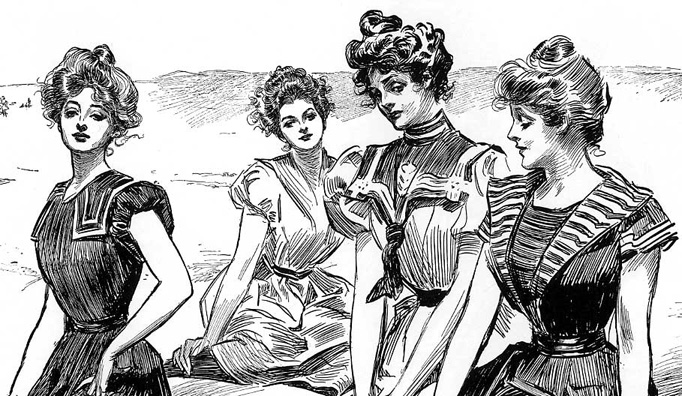
Girls at the Beach
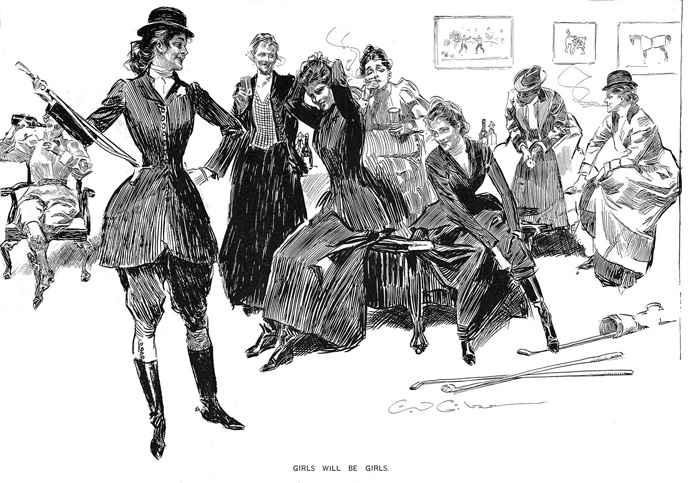
Girls Will Be Girls
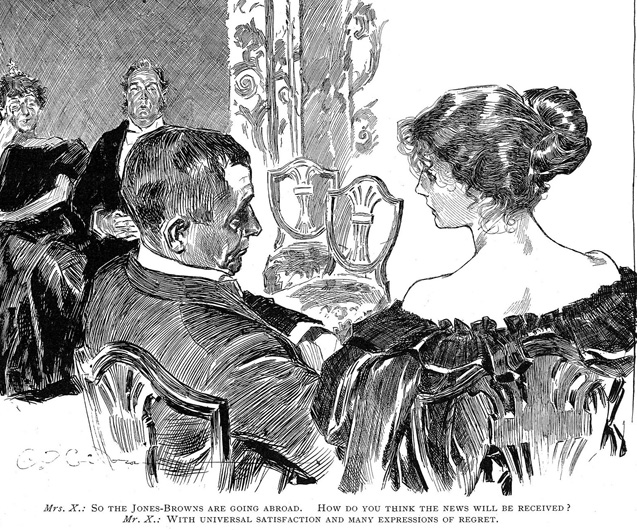
Gossip
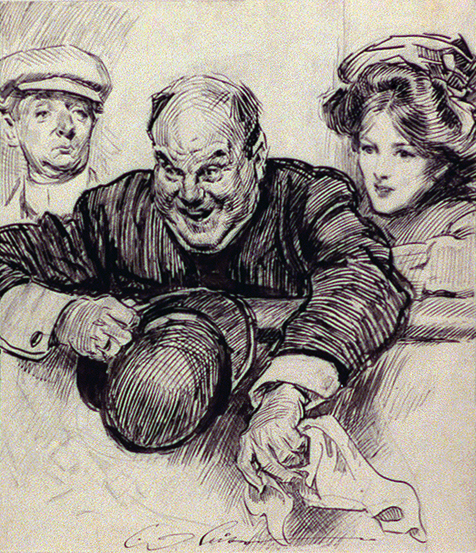
Home Again
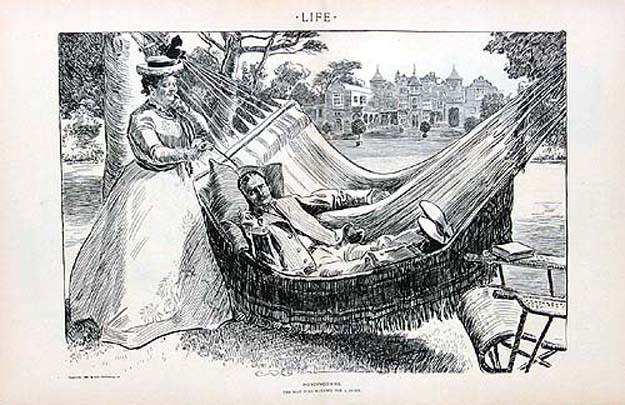
Honeymooning
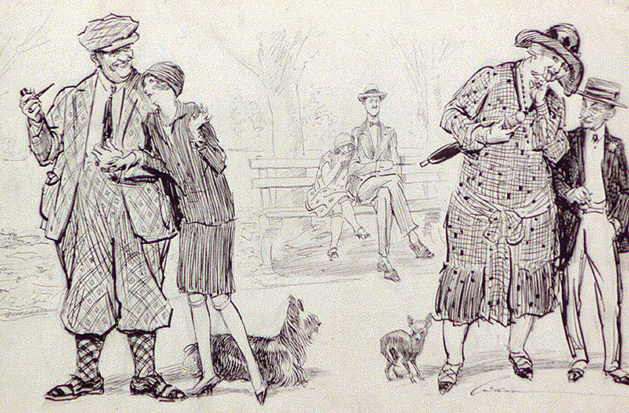
I wonder what those two can see in each other
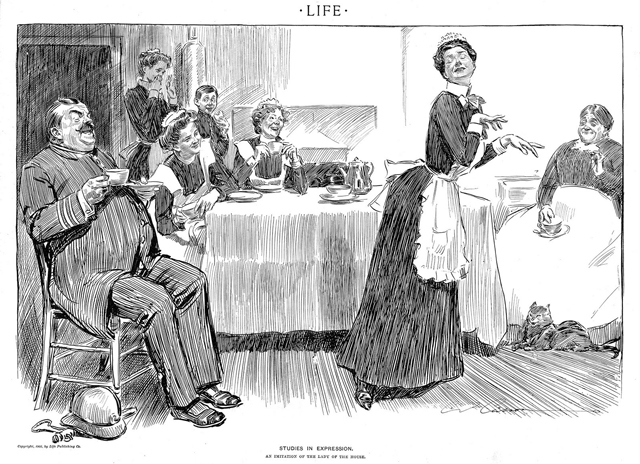
Immitation of the Lady of the House
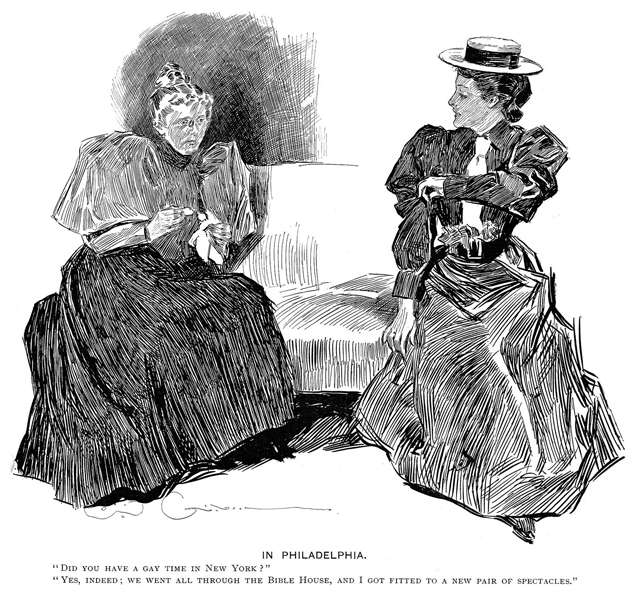
In Philadelphia
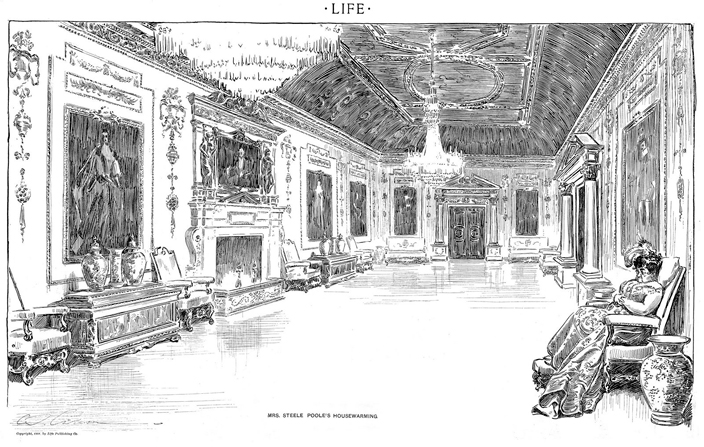
January 2, 1902
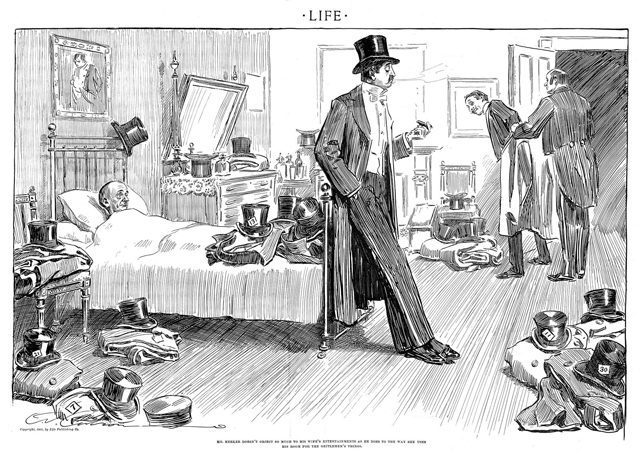
January 1902

June 1902

Lady of the Street - Bohemian
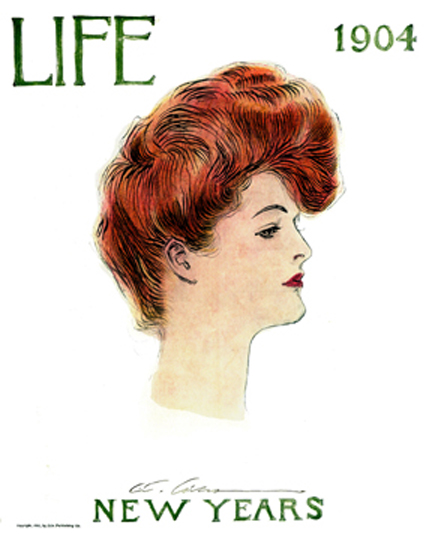
Life 1904
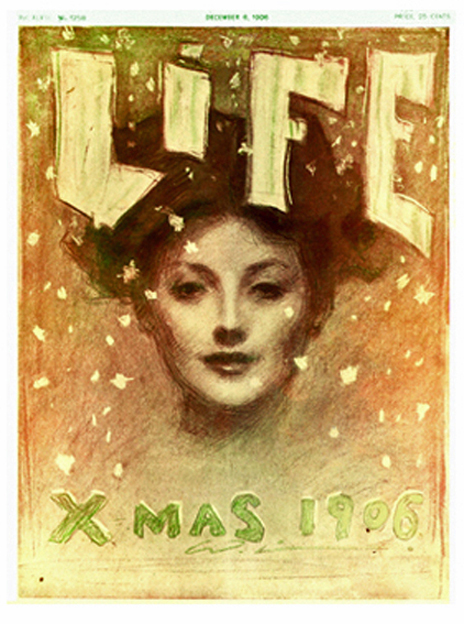
Life XMAS 1906
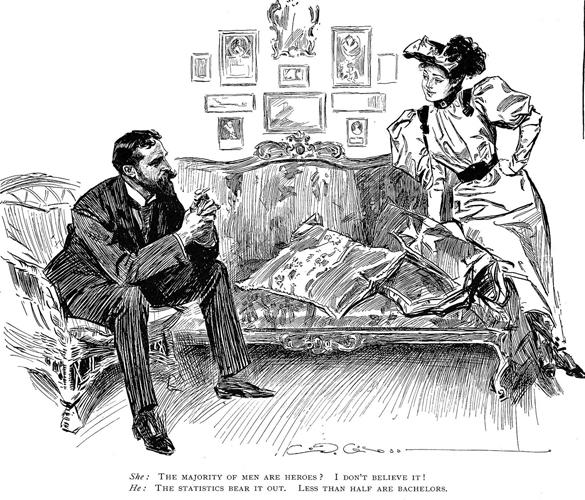
Majority of Men
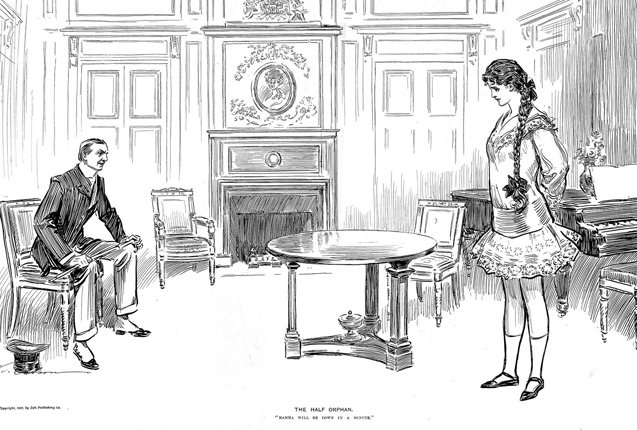
Mamma Will Be Down In A Minute
(The Half Orphan)
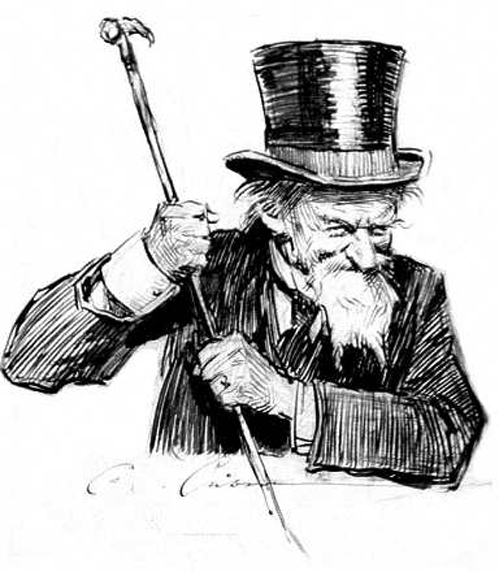
Man with Cane: 1911
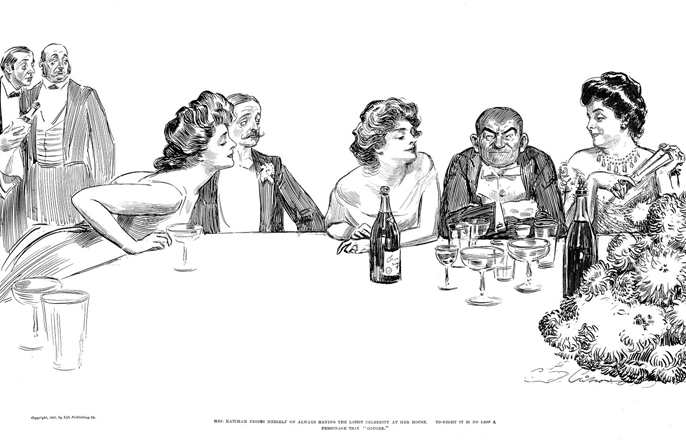
March 10, 1902
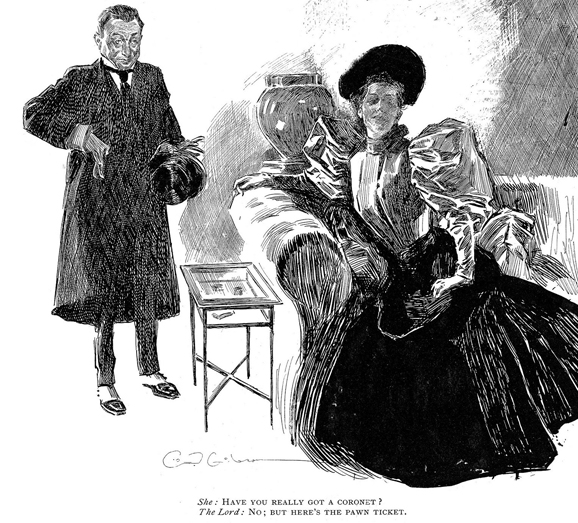
March 1896

March 1902
(Portrait of the Man Who Would Prefer a Short Wife and a Merry One)
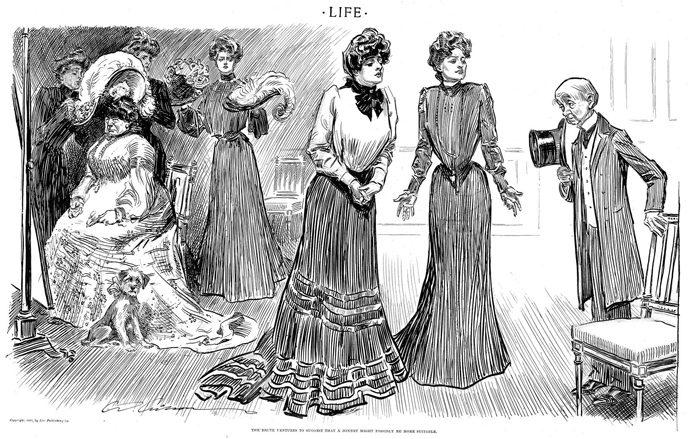
March 1903
(The Brute Ventured To Suggest A Bonnet Might Possibly Be More Suitable)
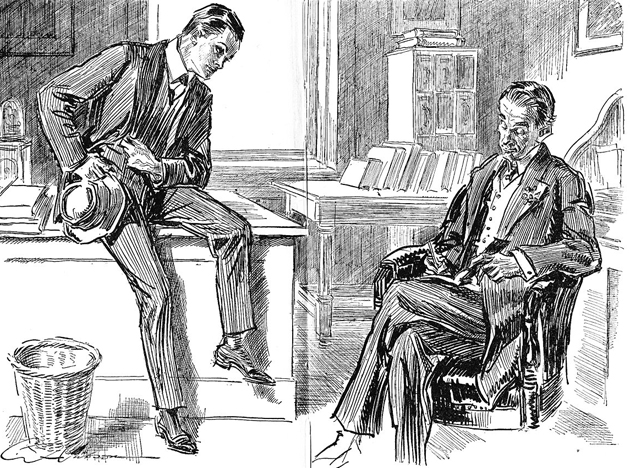
Meeting of the Minds
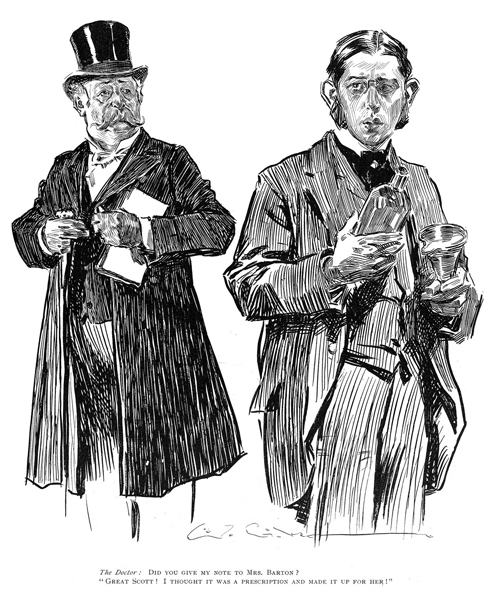
Mrs Barton

New Woman Scribner
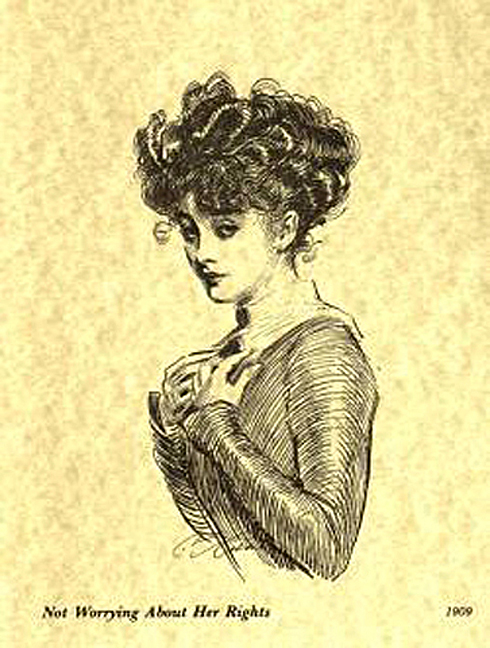
Not Worrying About Her Rights: 1909
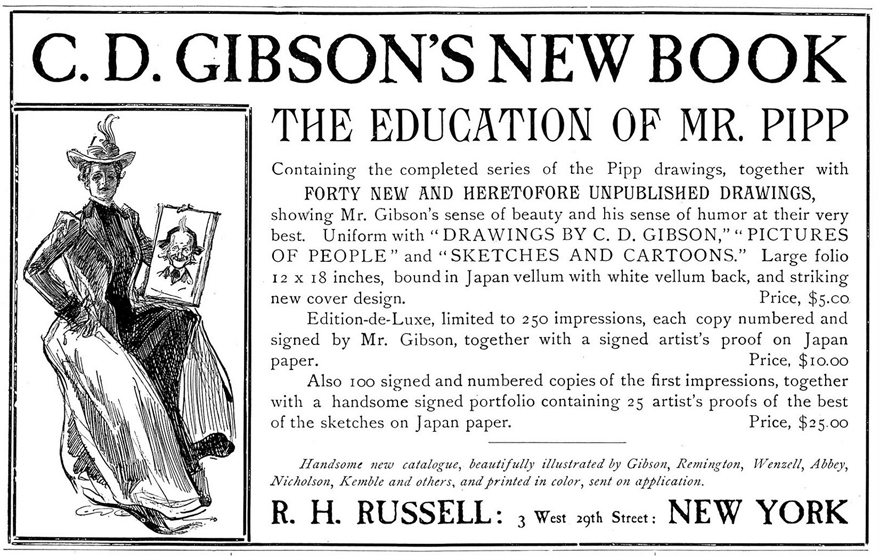
October 5, 1899
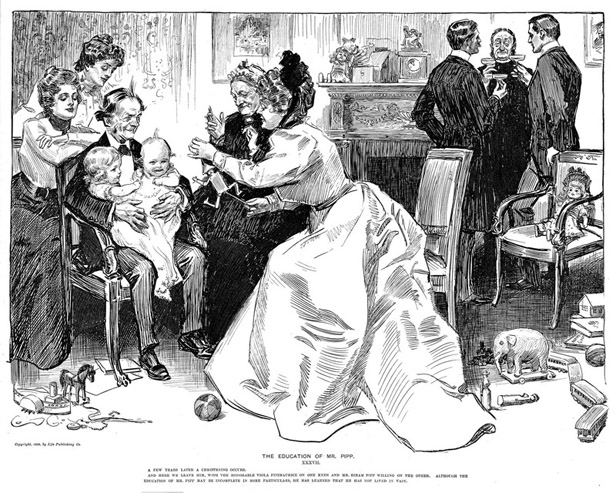
October 1899
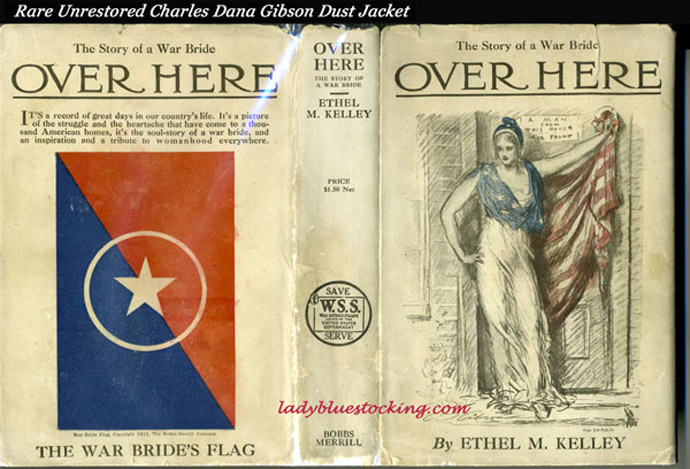
Over Here
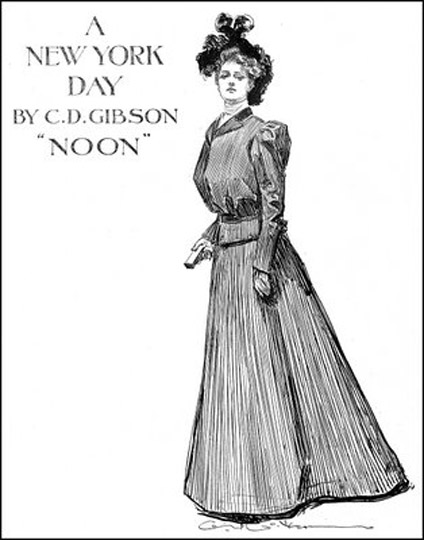
Scribners 1898, September
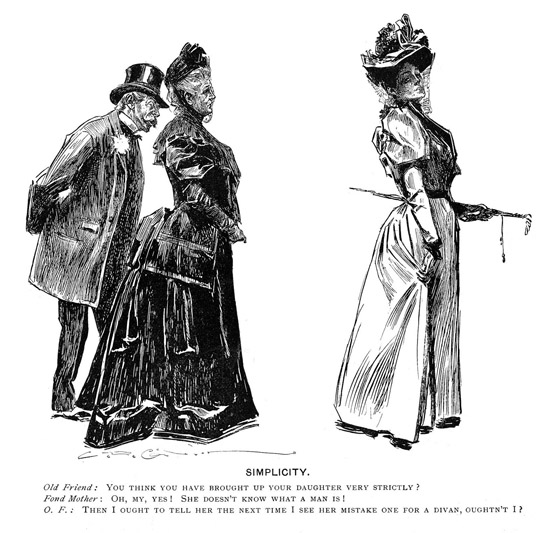
Simplicity
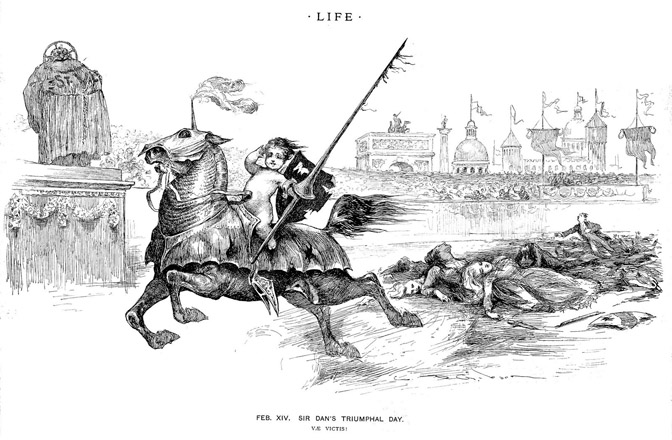
Sir Dan's Triumphal Day

Streets of Ascalon Bookmark
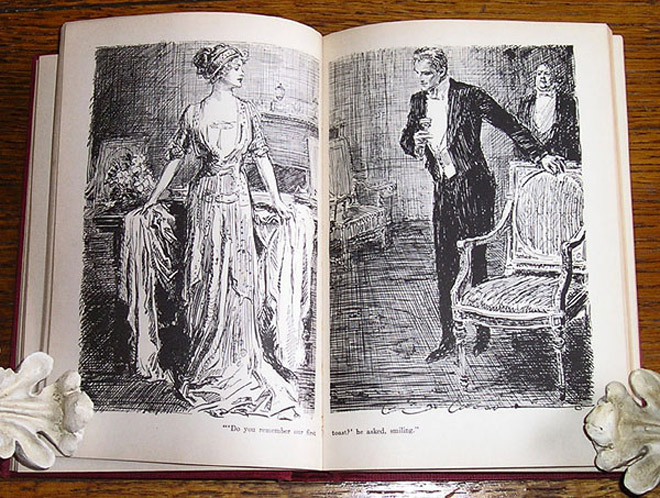
Streets of Ascalon Drawingroom
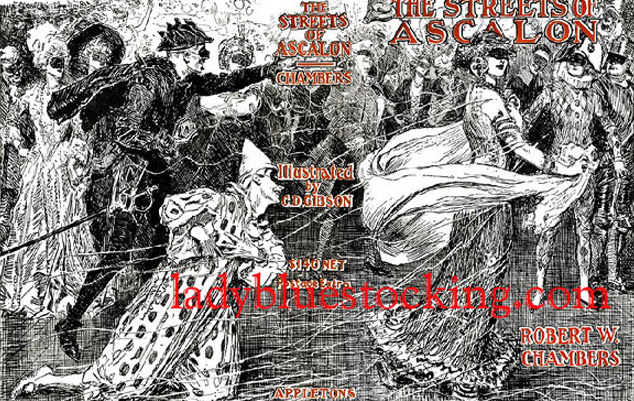
Streets of Ascalon
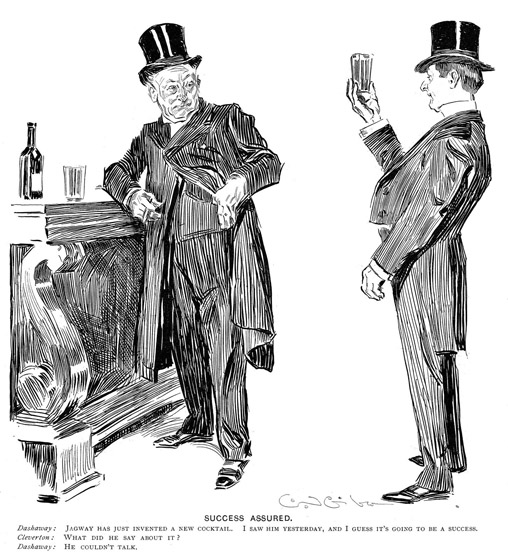
Success Assured
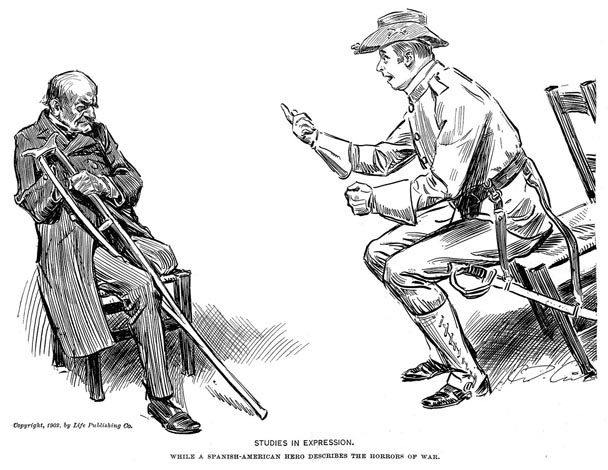
Telling the Horrors of War
(The Spanish American War)
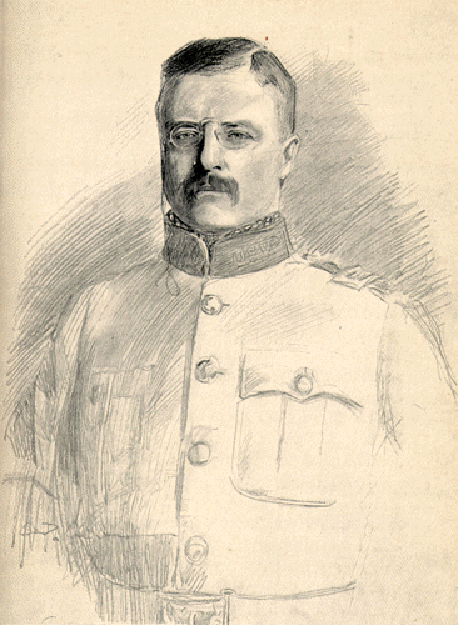
Theodore Roosevelt
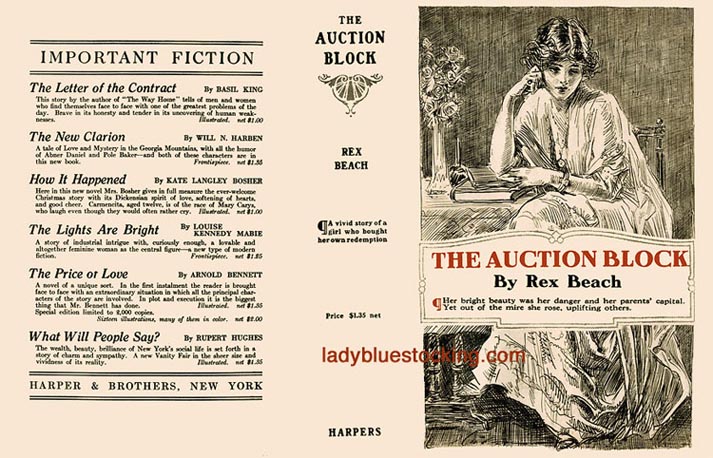
The Auction Box
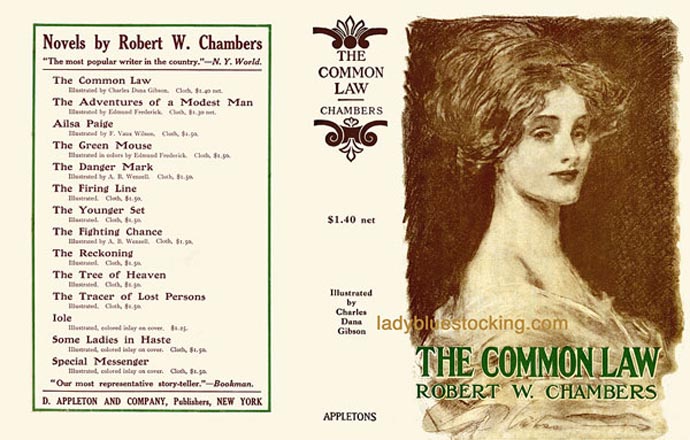
The Common Law
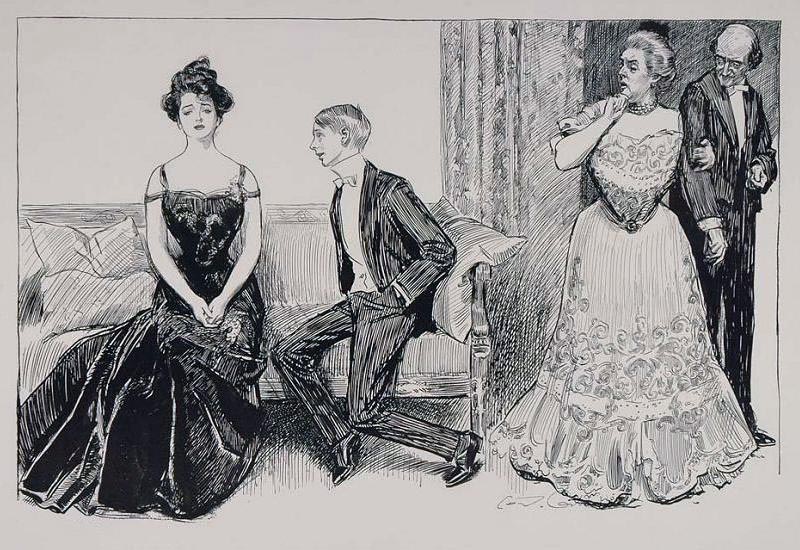
The Crush
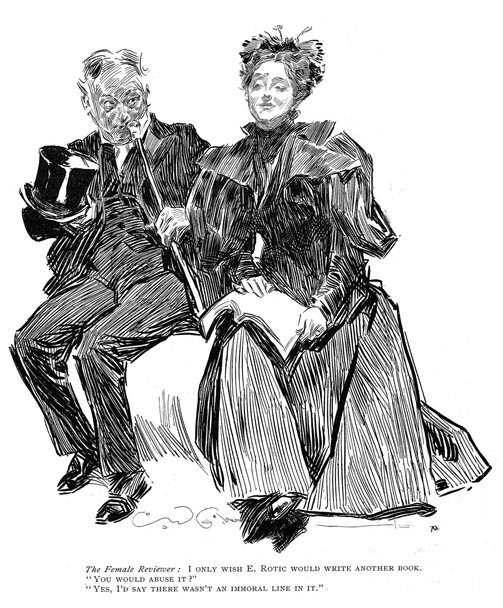
The Female Reviewer
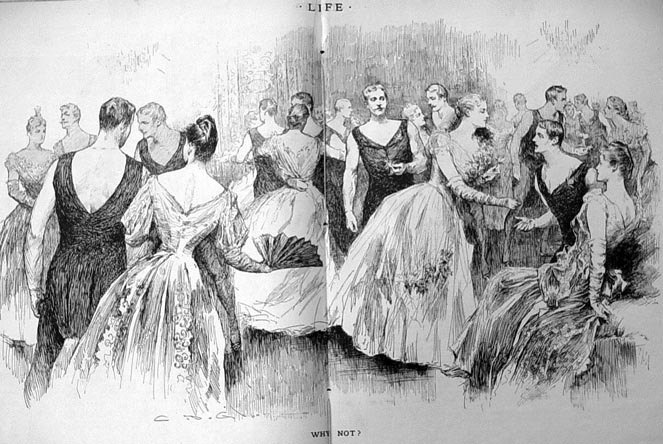
The Gibson Boys
(WHY NOT?)
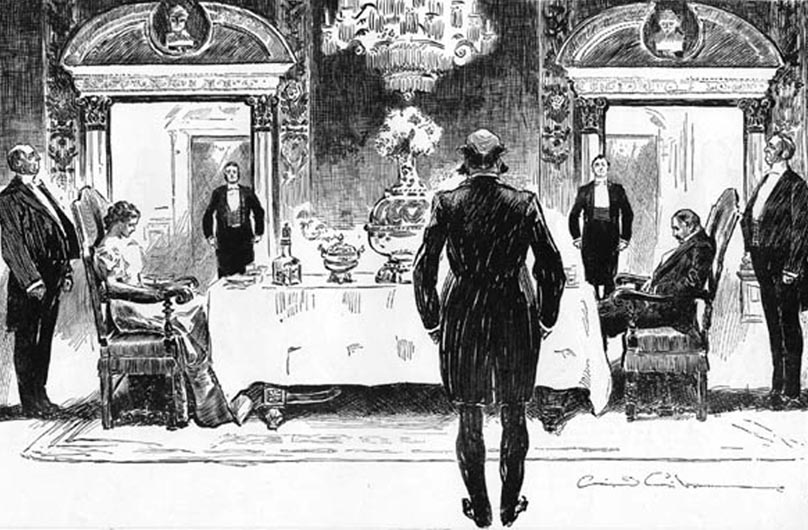
The Lucky Rich
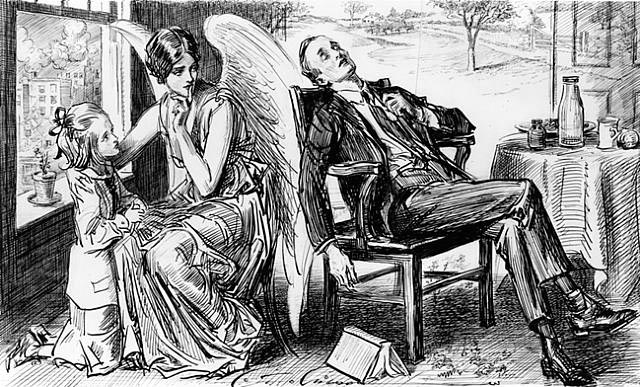
The Muse of Sleep
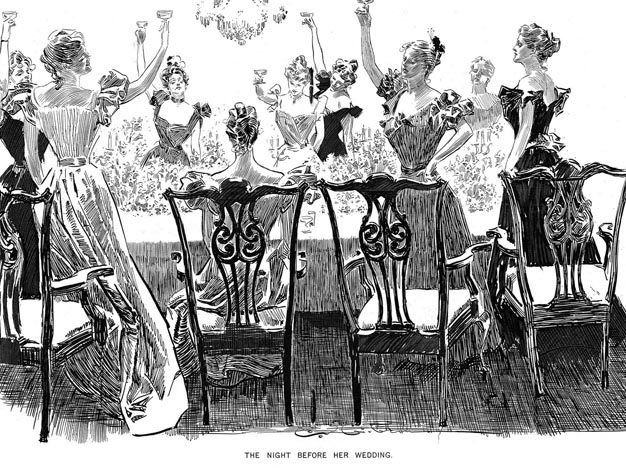
The Night Before Her Wedding

The Old Fashion Girl

The Puppy
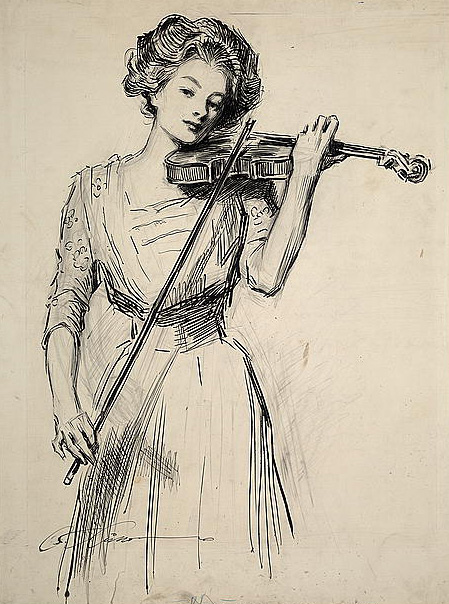
The Sweetest Story Ever Told
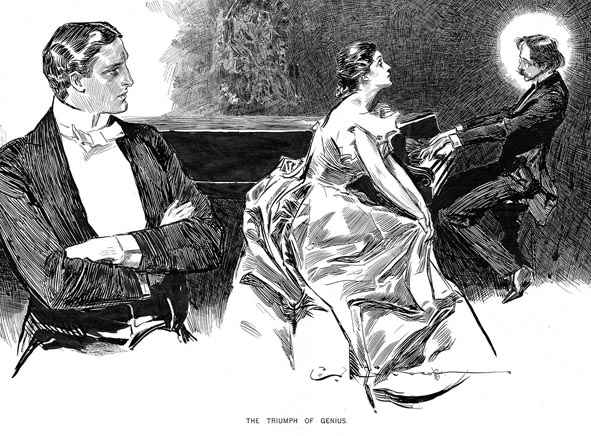
The Triumph of Genius
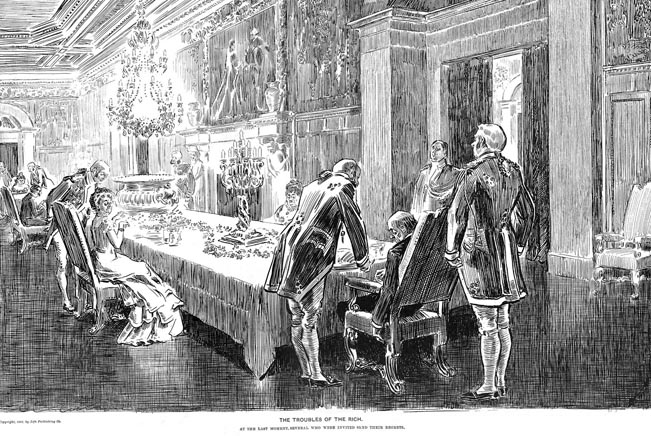
Troubles of the Rich
(At The Last Moment, Several Who Were Invited Send Their Regrets)
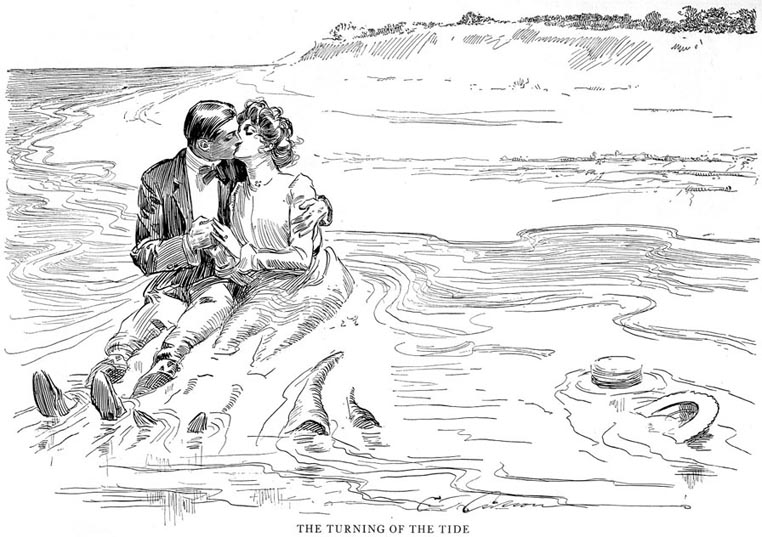
Turning Tide: 1900
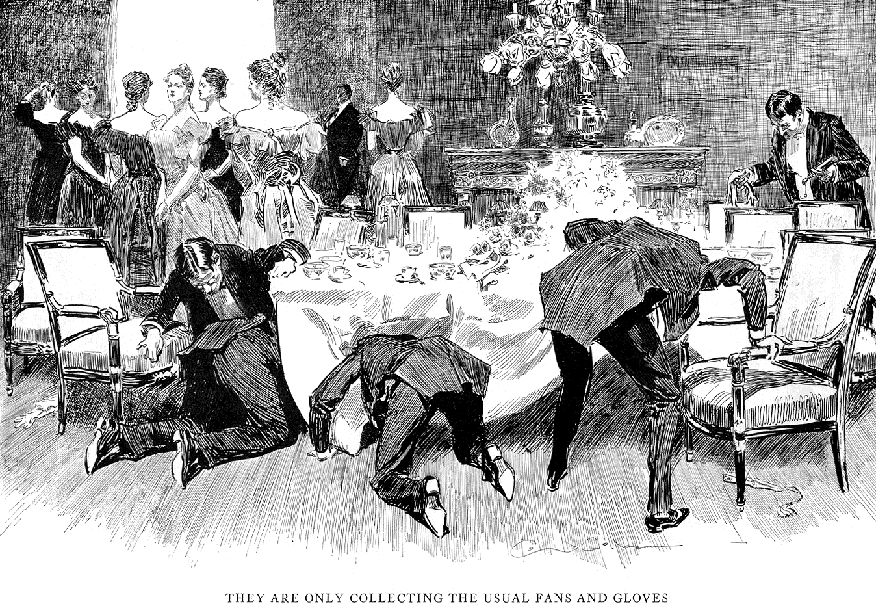
They Are Only Collecting The Usual Fans And Gloves

Why and Why Not
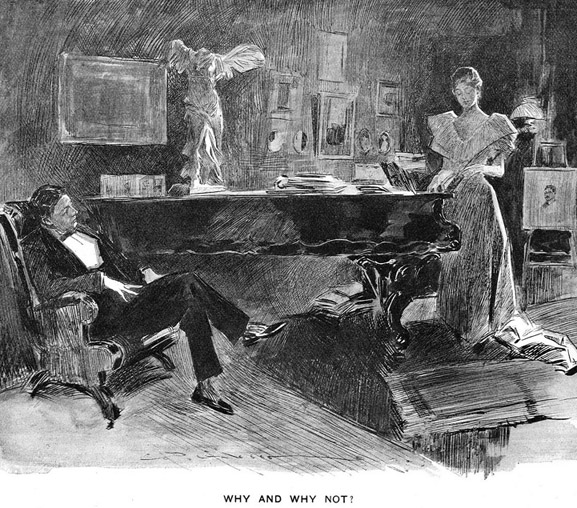

Woman Reading

Woman Typing
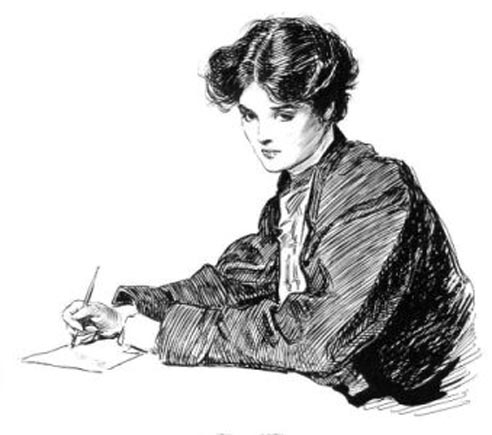
Woman Writing
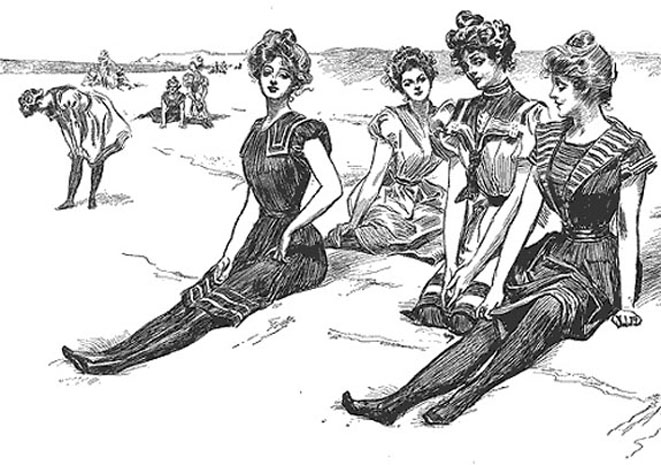
Women at the Beach
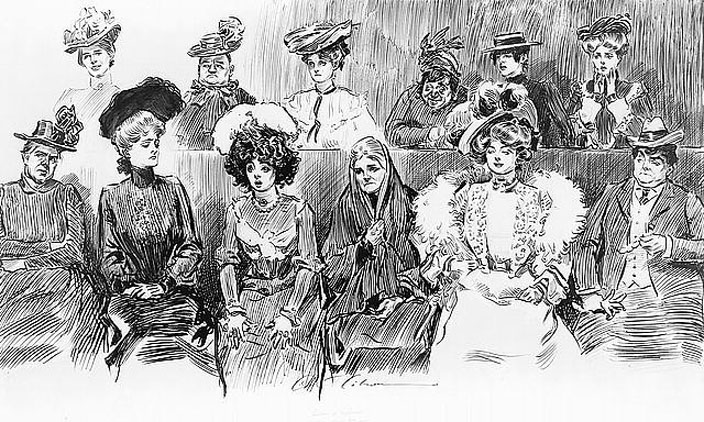
Women Jury
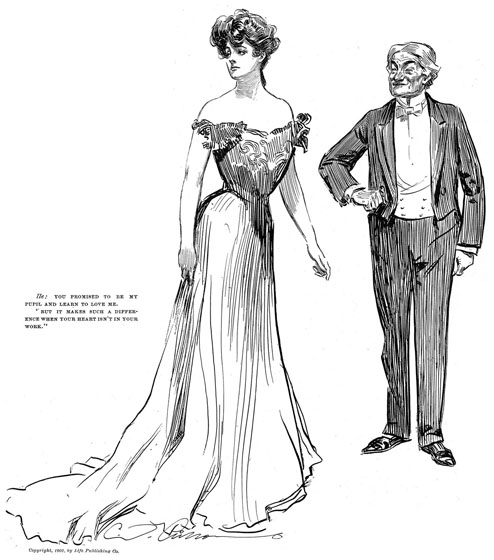
Young Woman - Old Man
In many ways I feel that the loss of illustrators such as 'Charles Dana Gibson' is a loss to the modern world. I believe that like many others the written word can create a visual image in our individual minds. Yet, the age of computers and digital graphics is just not the same as the skilled artist creating whatever it might be for our mind's eye. It could be individual characters showing emotion both active and passive or it could simply be advertising in trying to merchandise a certain product. Technology is wonderful but there is always a price to pay as we become more efficient. I make no judgments but only observations.
Senex Magister
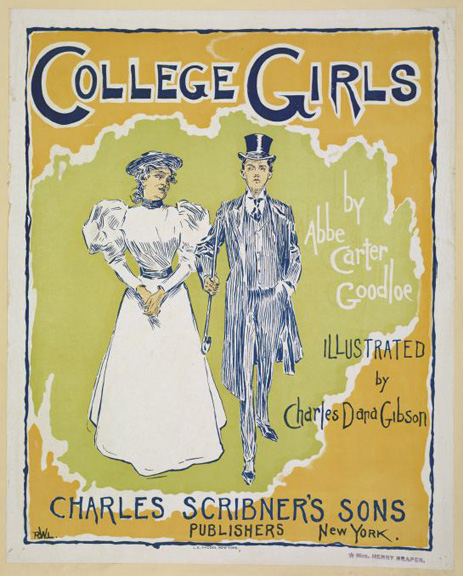
College Girls
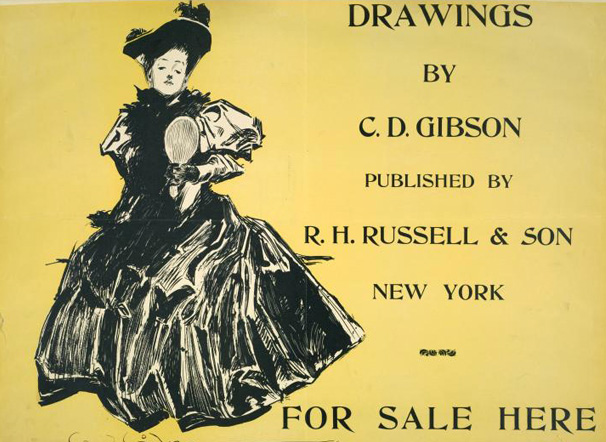
Drawings by C. D. Gibson
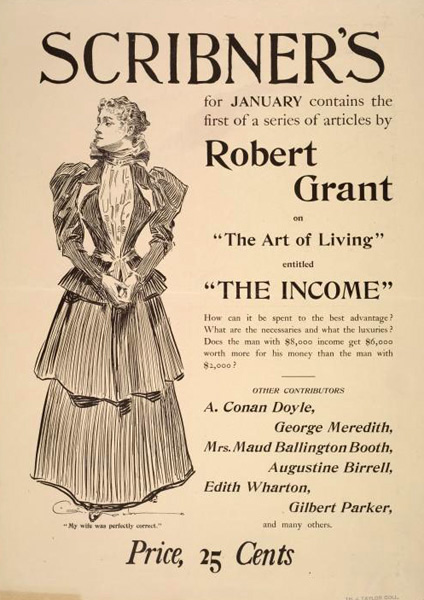
Scribner's Robert Grant
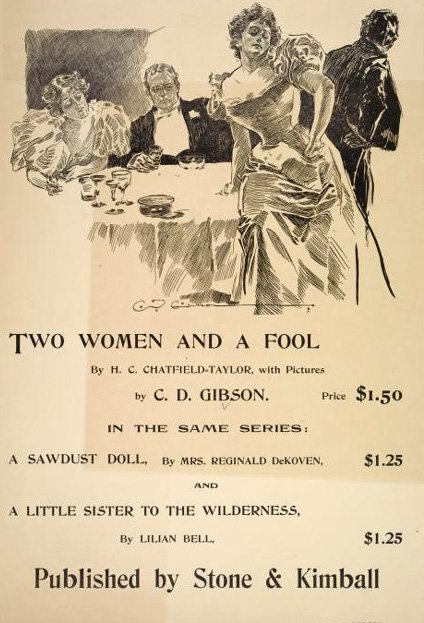
Two Women and a Fool
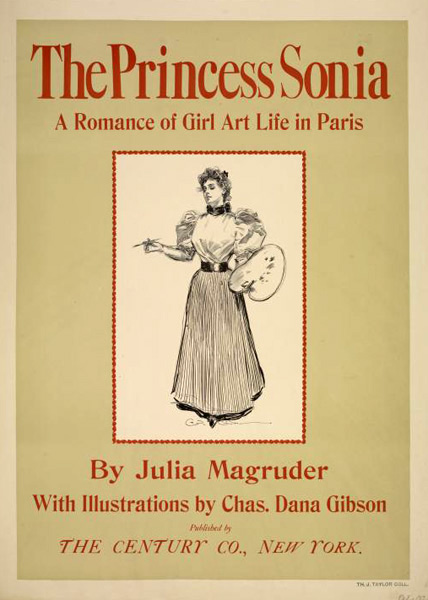
"The Princess Sonia
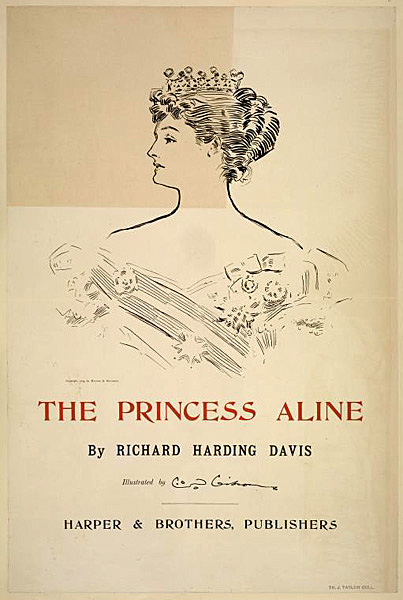
The Princess Anne
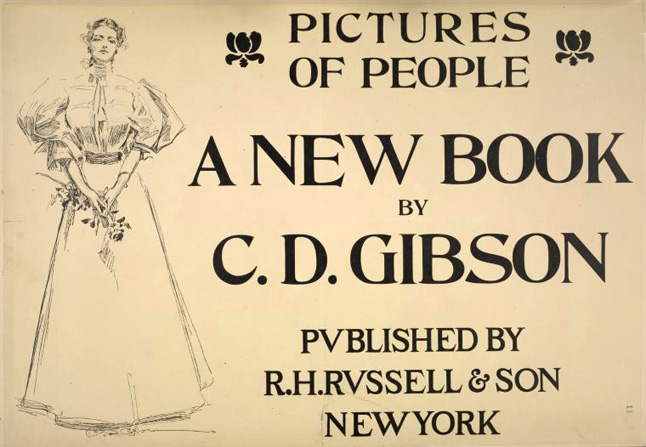
Pictures of People
What Else Can I Say?
It is always difficult when you take a glimpse at an individual and a society that faced challenges that we could never conceive. They may have held attitudes, mores, and even prejudices that today would seem very foreign to most of us. This is a pet peeve of mine even though I realize it is inherent in our human nature. What is it? Our tendency or a cultural bias that is so inherent that it is impossible to avoid. What is this rambling man talking about which causes him such frustration? The erudite among us call it ethnocentrisms believing that we and our culture possess a superiority because for some reason we got it right and everyone else has it wrong. This is the basic fault or fallacy in being human. All we have done then is to prove George Santayana correct when he said, "Those who cannot remember the past are condemned to repeat it." We have difficulty looking at history and society that is not contemporary to our own experience without imposing some kind of bias upon it which, I think, in the end limits mine (our) ability to truly understand their worth and merit.
What does this all have to do with Charles Dana Gibson? We or I might say everything or nothing. I am leaving you with a series of pictures of what I believe this man truly loved and probably did not completely understand in all the complexities and challenges that faced a 'Gibson Girl' or a woman in any era of human experience. Gibson's graphic drawings depict women in most emotional as well as carefree circumstances that one would encounter in life. Her full length gowns and being clothed from her neck to her toes at the beach gives her a sensual appeal that is hard to resist. What it is, I think, is the 'feminine element' whose power and influence we see first emerging in the ancient world especially among the Minoans on Crete. It is a search and a struggle for identity that continues to this very day for some but not all. My wife has often told me over the past 34 years that "I am Woman and I can do most anything." Femininity is a source of natural power in the world that is divine and cannot be diminished by the contrivance of man.
Senex Magister

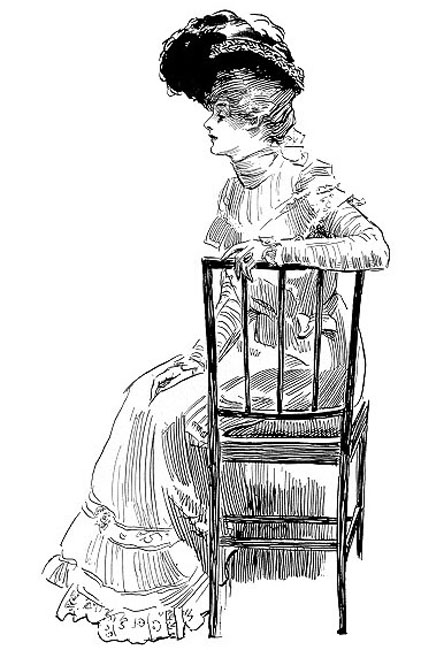
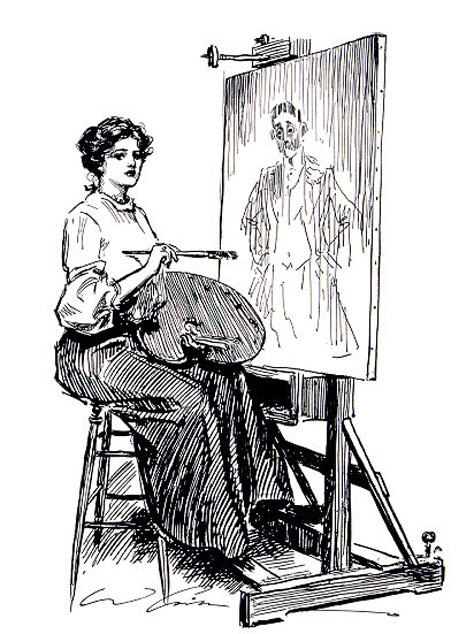


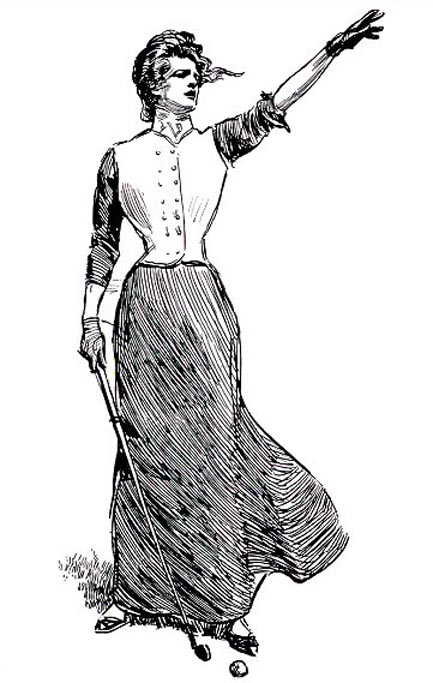
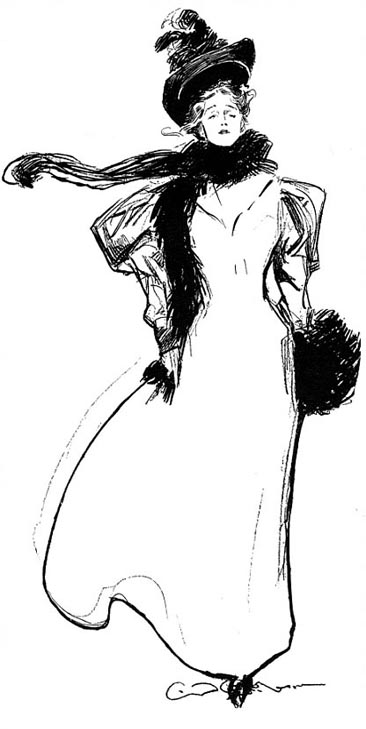
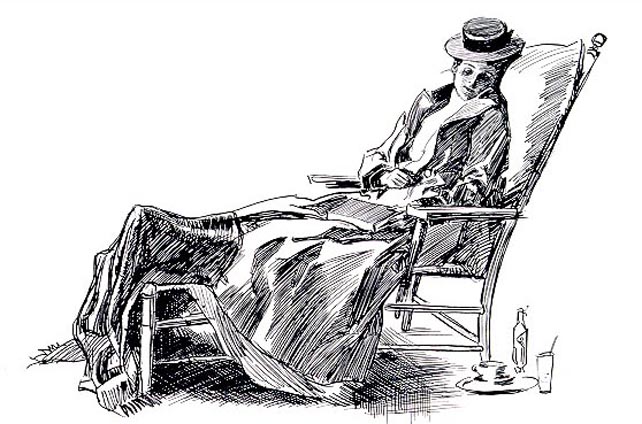

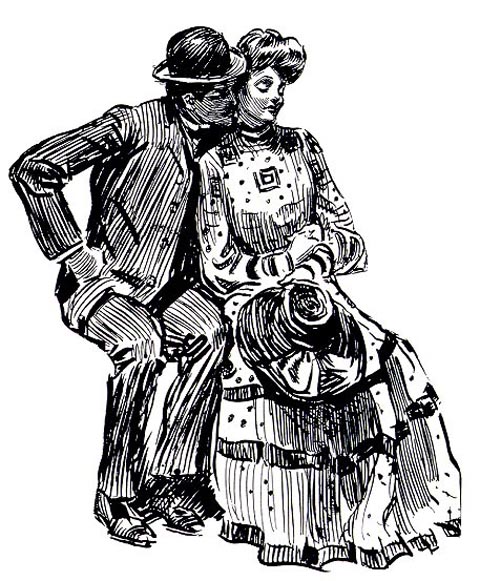

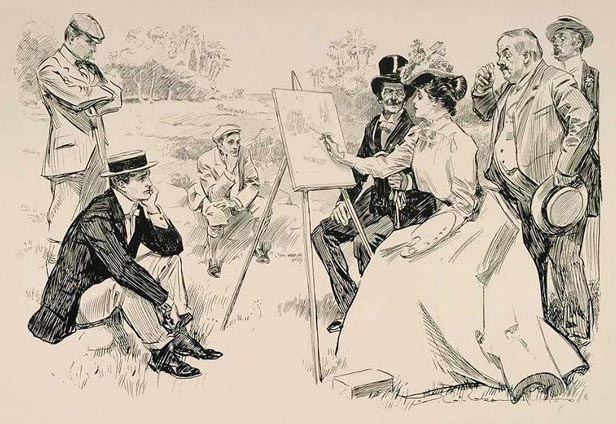
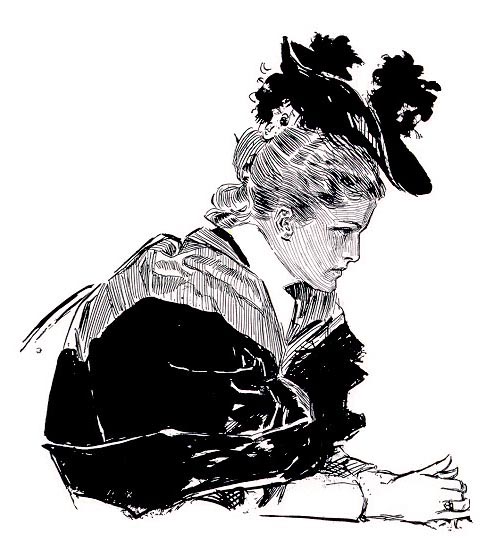
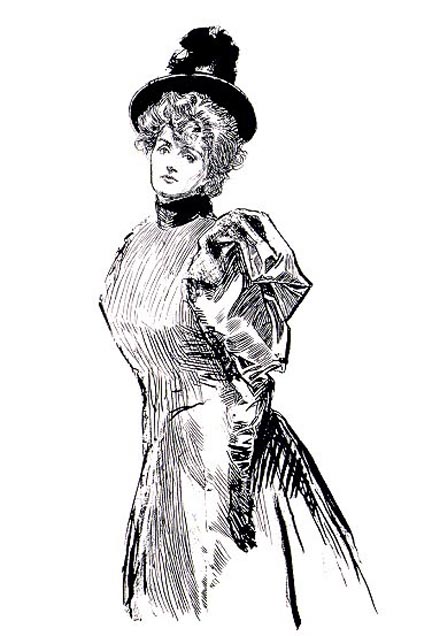
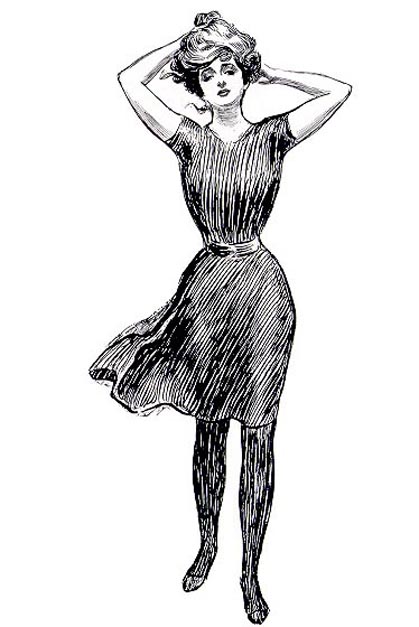
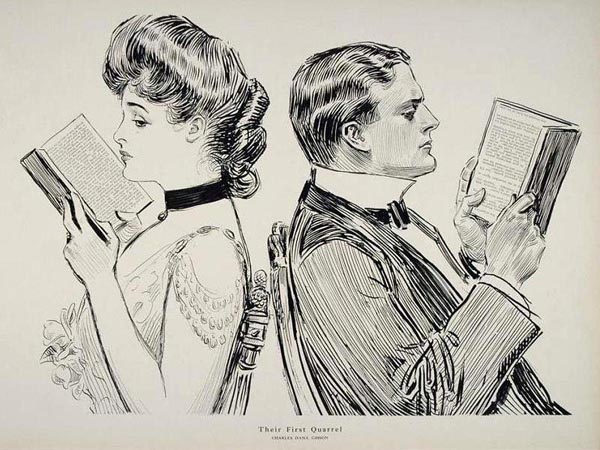
(Their First Question)
Sources:
Charles Dana Gibson - Gibson Girls
Charles Dana Gibson - The Herald Square Hotel
Return to Pagina Artis
Return to Bruce and Bobbie's Main Page.